October 9 - 15, 2016: Issue 284
Taronga Zoo 100th Birthday Parade: 1000 Reasons To Celebrate
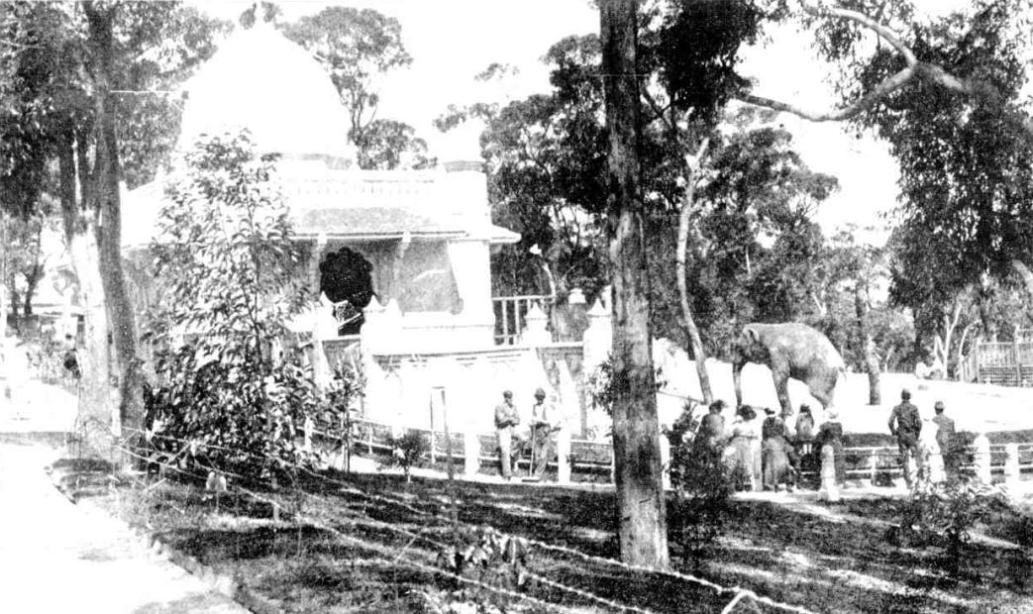
Above:
JUMBO'S PALACE AT THE NEW SYDNEY ' ZOO.'
MANY thousands of people have visited the new Zoological Gardens at Taronga Park, Sydney, and the general verdict is that the site and arrangements for the housing; of the animals and birds are infinitely superior to those of any other 'Zoo' in the Southern Hemisphere. 'Jumbo' remains as great a favourite as ever with the youngsters. Many of the animals have yet to be transferred from the old 'Zoo' at Moore Park. No title (1916, December 13).Sydney Mail (NSW : 1912 - 1938), p. 16. Retrieved from http://nla.gov.au/nla.news-article160388649
Taronga Zoo 100th Year – Now An Ark For The Ages
In recent Issues we’ve been able to share some great news coming out of Taronga Zoo and the NSW Environment Department regarding being a lot more responsible for the other creatures we share this planet with.
The announcement that another new baby Asian elephant will soon grace us with its presence, a species that is endangered in its own habitat, as well as local students being engaged in activities to broaden their understanding of penguins at Manly, or the great Taronga Parade that will take place next Saturday, October 15th, to recreate and even celebrate the shift from the old zoo at Moore Park to Taronga, are stories that bring a smile to all age groups.
The Taronga Birthday Parade gives us an opportunity to share some historical items we’d been collecting and saving for just such a celebration.
Last year, in National Bird Week 2015, the Aussie Back Yard Bird Count: and Australia's First Bird Counts - a 115 Year Legacy we shared some information about Sydney’s first zoo on grounds known as Billy Goat Swamp in Moore Park, operated by the Zoological Society of NSW (founded in March 1879.) and the people behind it, especially the family who were instrumental in ensuring something bigger and better occurred.
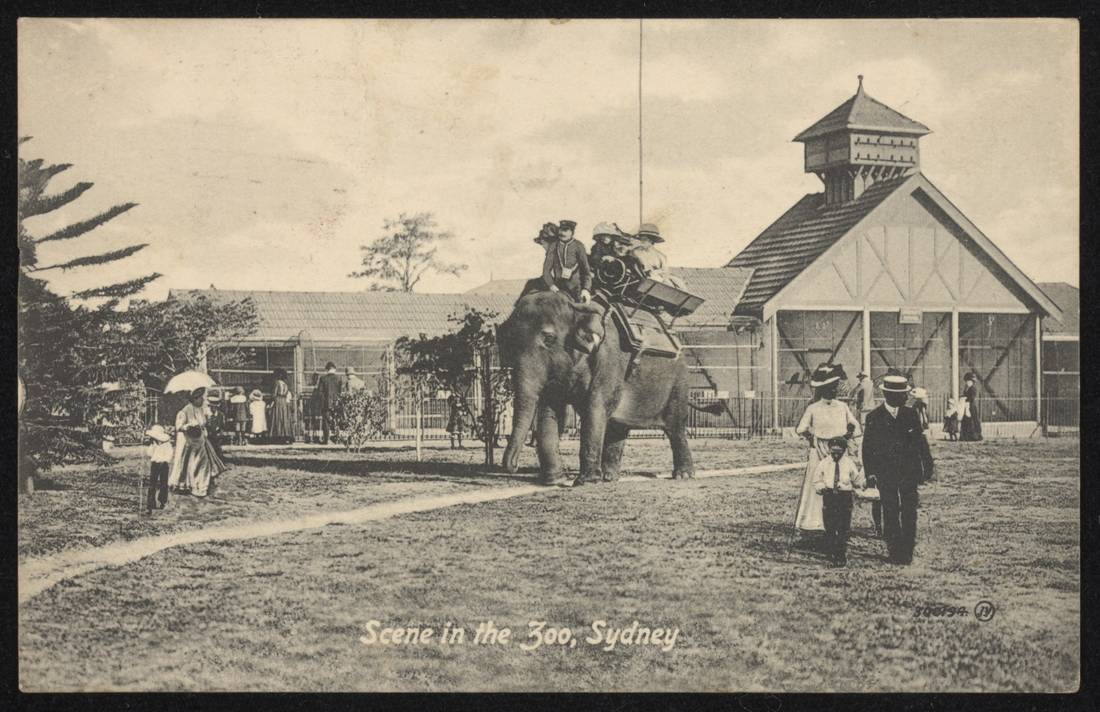
'Scene in the Zoo, Sydney' postcard, 1912. National Museum of Australia. (Moore Park)
After a visit to Germany in 1908 the elected Secretary of the zoo, Albert Sherbourne Le Souef, returned with a vision for a new Sydney zoo, based on the bar-less exhibits of Hamburg Zoo. The site at Moore Park had become too small and was not suited to the vision. A new site for the zoo was sought. On April 24th, 1912 the NSW Government granted 43 acres of land north of the harbour which were part of Ashton Park. Another 9 acres were granted in April 1916.
This was all part of a larger vision for the foreshores of Sydney that began in 1911:
A HARBOR PARK.
BEAUTIFUL BRADLEY'S HEAD.
A GREAT IMPROVEMENT WORK.
Following upon recent published statements regarding the condition of what is familiarly known as Bradley's Head, and officially is designated "Ashton Park," a representative of "The Sun" was afforded an opportunity, a few days ago, of accompanying Mr, Furber, Metropolitan District Surveyor, who is one of the trustees of the park, on a visit of Inspection.
Bradley's Head is the most conspicuous landmark in Sydney Harbor. Standing out conspicuously on the northern shore, it looks to the voyager entering Sydney Heads as though it stretched right across the harbor. Also it is the highest land around Port Jackson. Until about three years ago it was held as a military reserve. Once it was a fort commanding the entrance to the harbor and the channel to the anchorages, and the old gun emplacements are still to be seen on the high land at the Mosman end of the peninsula. Now the area has been handed over to the State for recreation purposes. Trustees have been appointed, and they have set about making such alterations as will convert the rocky, heavily-limbered heights into one of the most delightful pleasure resorts In New South Wales, and one of the finest view points in the world.
For many years Bradley's Head has been terra incognita so far as the public were concerned — firstly, because of the military restrictions placed upon access to defence positions, and, later, because it was a stock quarantine ground. Now the whole of the 140 acres is open to the public, who may wander about to their heart's content, with only one condition to observe — namely, that they shall not pick the flowers nor destroy the trees and undergrowth — and there is no possible doubt that when once the place begins to get known it will be an unrivalled rendezvous for pleasure-seekers, and a part of Sydney that visitors will not be allowed to miss seeing.
Although they have been hampered by want of money, the trustees have already done much in the way of preparing the park for the public. Convenient flat spaces have been cleared for picnic parties, rustic fire-places have been constructed, a water supply system has been" Initiated, and seats have been placed in shady nooks commanding magnificent views of the harbor and the surrounding shores. But the finest work of all is the making of a footpath from the eastern shore line of the park, at Chowder Bay, right round to the "Lookout" on the heights above Mosman— a track which it is intended to continue round Whiting Beach and Sirius Cove to the other side of Mosman. This walk has been so laid out as to ensure that the contours of the land shall be preserved and the trees and rocks interfered with as little as possible, and as it winds around the rocky headland it Is taken from vantage point to vantage point through pretty glades, and from each of these points some fresh view is obtainable, each one coming upon the sightseer unexpectedly, and disclosing pictures calculated to arouse the enthusiastic admiration of even the most matter-of-fact.
From here the view stretches out to Sydney Heads on the one hand and across Watson's and Rose Bays to the ocean on the other; from another point the picture includes the whole of Sydney and the country beyond; and again a charming glimpse is obtained down frowning gulches to the tide-washed rocks below. It is an ever-changing panorama that Is presented as one strolls up and down the easy grades of the couple of miles of walk, and when In the future the finances of the trust admit of larger undertakings, the track will be widened into a drive, and carriages and motor-cars will be found in regular procession, making a tour through scenery that is unsurpassed in Australia. It is not the intention of those entrusted with the care of the park to interfere with the natural beauty of the place more than Is absolutely necessary, but dead undergrowth will be cleared away and cross-tracks will be made through the timber, so that it shall not only be the harbor front that Is accessible to the public. The park is easy of access, too. On the one side there is the ferry service to Clifton Gardens, on the other that to Athol, and in the future there is no doubt there will be another wharf at the head of Sirius Cove, from which a road can be made without difficulty to the Lookout. A mile of tramline from the Military-road along Prince Albert-street will connect the park with the Mosman ferry and all the northern tramway system. From the rocks below the headland and In Taylor Bay, as well as at Whiting Beach, fishermen should find good sport; the adjoining beach at Sirius Cove provides opportunity for safe bathing and swimming — everything combines to make Ashton Park a place for pleasure. And It is within twenty minutes journey by water from the city. All that is necessary now is for the Government to provide funds so that this beauty spot may, after many years of waiting, be put into a proper condition for the public to thoroughly enjoy and appreciate it.A HARBOR PARK. (1911, June 2). The Sun (Sydney, NSW : 1910 - 1954), , p. 8. Retrieved from http://nla.gov.au/nla.news-article221591878
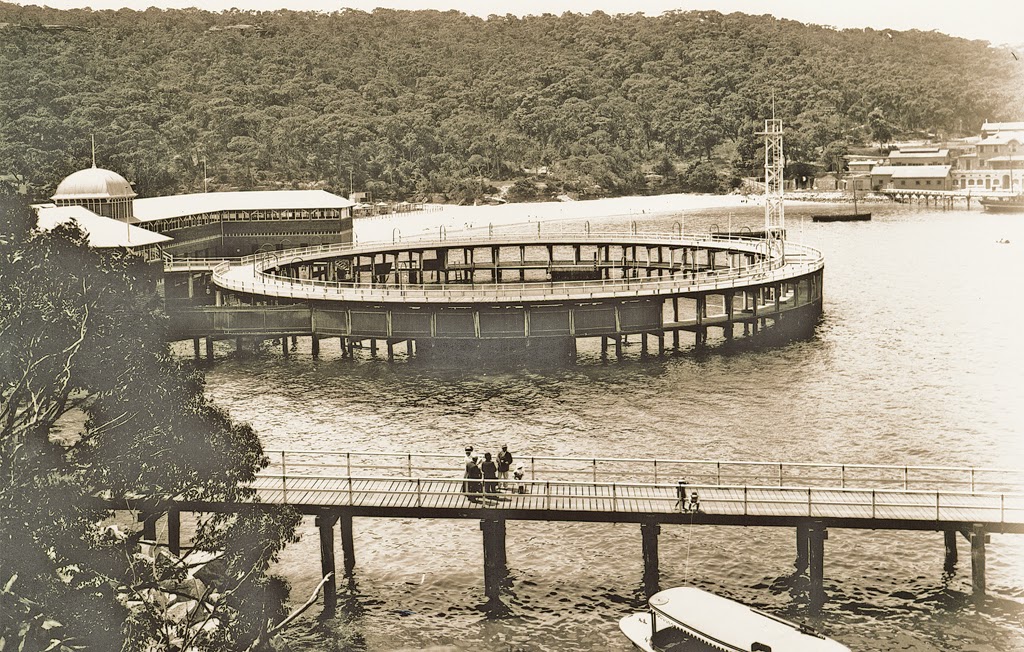
Clifton Gardens, circa 1909
FOR THE PEOPLE
THE FORESHORES.
HARBOUR RESUMPTIONS.
£150,000 TO BE SPENT.
MR. NIELSEN'S BOLD POLICY.
What do they know of Sydney who only the city know?
Yesterday afternoon a Parliamentary party, headed by the Acting Premier. Mr. Holman, and Mr. Nielsen, Minister for Lands, went down to Clifton Gardens in the Government launch Premier, and walked through Ashton Park as far as Athol Gardens, a distance of about two miles, and it was remarked that "the Sydney people know nothing about it." To a large extent this is true. A track has just been cut through this beautiful park land close to the water's edge -it has not yet been completed in places and from many points some of the finest views imaginable are to be seen. Those are not merely views of the harbour and city, in themselves exquisite, but also of the beauty of nature that lies here, virgin and all unspoiled, beautiful verdure and gum trees, lovely glades and rugged, rocky scenery. It was National Park; it was the Blue Mountains, in Sydney itself.
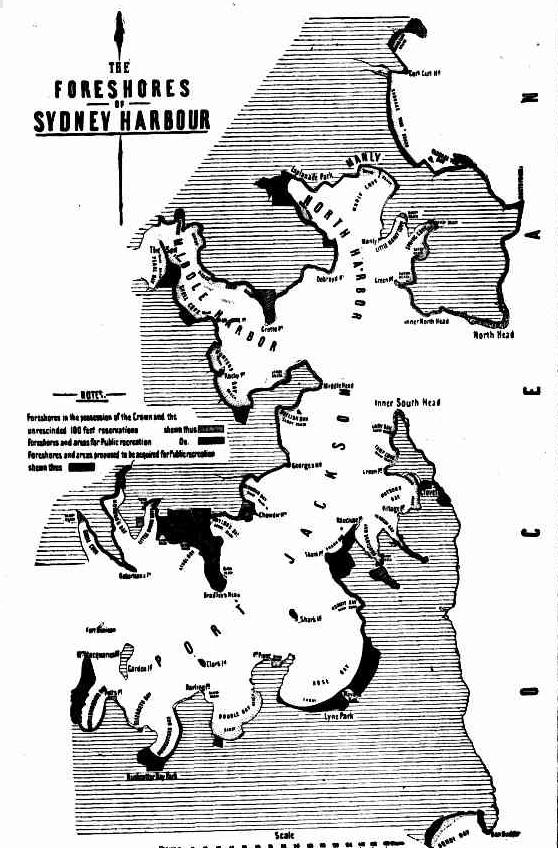
All told, Ashton Park, which the Government intends shall be made more accessible to the people than it has been in the past, comprises 143 acres, and the object of yesterday's gathering was to give the Minister for Lands an opportunity of making a public statement regarding his policy of harbour
PROJECTED HARBOUR FORESHORE RESUMPTIONS.
foreshores resumption. The all-night sitting In the Assembly doubtless kept some away who otherwise would have been present, but as It was the gathering numbered about 50, including both Ministerialists and Oppositionists, members of the council of the Zoological Society, the trustees of the park, and the Mayor and aldermen of Mosman. Dr Arthur, member for the district, was among those present.
There is a proposal that 40 acres of park lands shall be devoted to the purposes of Zoological Gardens, the present gardens, in Moore Park, having cramped and unsuitable in other respects. It is understood that this proposal has the support of the Government, and it is intended to ask for a substantial grant, with a view to the Sydney Zoological Gardens ultimately taking rank among the finest In the world-probably between £60,000 and £100,000, spread over several years. The site itself is said to surpass any other in the world for the purpose In view.
On arrival at Athol Gardens, the well-known picnic spot, which has been lately resumed by the Government, and added to the Ashton Park land, the 'party sat down to luncheon in the large hall.
THROWN FROM PILLAR TO POST.
The health of the Minister for Lands was proposed by Mr. Holman, who said that this gathering was duo to Mr. Nielsen, and the exertions he had put forth in the matter of foreshores resumptions during the past three months. On behalf of the Government, Mr. Holman welcomed the presence of members of the Mosman Municipal Council, the trustees of the park Itself, and the members of the council of the Zoological Society. The latter had come armed with a "knock-out" proposal that would presently be disclosed. (Laughter.)
He was also glad to see a large number of "assorted members of Parliament, with a variety of political opinion and personal reputation,' In spite of an all-night sitting forced upon the Government by the occasionally pig-headed Opposition." (Laughter.) The Government felt under a deep debt of gratitude to Mr. Nielson for what he had already done in connection with the foreshores problem. Representations had been made for years as to the necessity for doing something to preserve the harbour foreshores for future generations. The matter had been thrown about from pillar to post. It went to the Chief
Secretary's Office and to the Works Office, and finally Mr. Nielsen took hold of It. They would find, after hearing Mr. Nielson, that they had really arrived at a nearer solution of this great question than ever before. (Applause.) The whole credit was due to the present Minister for Lands, and if the whole State did not consider itself fortunate in having such a Minister he could only say that the party now in power considered itself very fortunate in having a man of his powers and energies. (Applause.)
THE SPENDING OF £150,000.
In replying to the toast, which was enthusiastically honoured, Mr. Nielsen said he had simply been doing a duty, though he had found much pleasure in doing it. Although he had been living in Sydney for the past 12 or 13 years, ho must plead guilty to having known very little about Sydney harbour up till n few months ago. Owing, however, to the fuel that he had had to visit the localities of the proposed resumptions from time to time, he believed ho now had as good a knowledge of the harbour as anyone In Sidney. The duty had been cast upon him chiefly because no one else liked to take it up. "I took it up," he went on, "with the Idea of going Into the question very fully, without allowing any local Ideas or prejudices with regard to any particular place to Interfere with my judgment. I looked at the matter purely from the point of view of the future of Sydney harbour, and the interests of the present and future generations. (Applause.) Sydney harbour is not only a Sydney institution, but it belongs to New South Wales: and In what I have done I have looked at the matter from the point of view of the country as well as the city people. (Hear, hear.) I disagreed with the idea of doling out £20.000 or £30,000 a year for doing this work. Every acre, every hundred feet, resumed on the Sydney harbour frontage would mean that the whole of the frontage left would become more and more valuable. So I asked the Cabinet to allow me to have a fairly large sum in the first instance, making that do for some years to come. The first thing that struck me in going around Sydney harbour was the want of forethought on the part of those who had governed the State in the past-(hear, bear)-by allowing such an enormous area of those beautiful water frontages to be taken away from the people. What could have been done with a few thousand pounds a few years ago now runs into hundreds of thousands, and if It were to be left for future generations to grapple with, they would have to pay not only more in thousands, but in hundreds of thousands. It was necessary that it should be dealt with at once, and on n scale of some magnitude." (Applause.)
DETAILS OF THE RESUMPTIONS.
The Minister then proceeded to detail the resumptions he had made or proposed to make. The first resumption he made was the little block of land on which they were at that moment-seven acres in extent. Portion of It had belonged to the Sydney Ferries Company, and the rest to a private individual. This great park, containing 143 acres, including the seven acres that had been resumed, had been obtained from the military authorities some time since, but nothing had been done until he took office. He appointed a trust for Ashton Park, including such men as Colonel Vernon (Government Architect) and Mr. J. H. Maiden (Director of the Botanic Gardens). He had surprised his colleagues, and especially the Treasurer, by telling them that unless they allowed him £150,000 to start with nothing of any value could be done. After some argument the Cabinet agreed. He might tell them that he had practically spent the whole of that amount already. (A voice: You have spent it well, too!) He did not intend to pay any impossible prices for resumptions. He would not allow any private individual to overcharge him, and so prevent this work being done. He was not going to force people to sell, unless it appeared absolutely necessary. A good deal of the resumptions would depend upon the price the Government could get the land for. He asked the owners to do the fair thing by the Government, and the Government in Its turn would do the fair thing by the people of Sydney and New South Wales. (Applause.) Starting from Rose Bay, he intended to put a sea-wall eastward from Lyne Park, making a proper contour of that bay. Some time ago the Into Mr. O'Sullivan made a reclamation, and called it Lyne Park. The effect of that reclamation was that it stopped the wash of the tide from going round the bay, with the result that the flats in the vicinity were becoming very offensive. He had now decided that the only way to got out of the difficulty wan by erecting a sea-wall and dedicating the reserve to the public for ever.Altogether-57 acres would be resumed-one resumption of 44 acres, and another of 13 acres. The residents, who now had a frontage to the offensive flats would eventually have a frontage to one of the finest public reserves in the State. Then he proposed, to continue the resumption, 100ft wide, along the bay to what Is known as the Wentworth Estate. That the Government had practically taken possession' of as a whole. The area extended from Shark Point to Bottle-and-Glass, and at the back of that was an area 54 acres in extent, which would also be dedicated to the use of the public for over. (Applause) This Included that beautiful eminence that commanded almost as good a view as did the eminence of Ashton Park. All this would give a total frontage of 2 ½ miles to Sydney Harbour-all absolutely now frontage and would "have the effect of bringing 113 acres of the foreshores back to the people." (Applause.) He had also resumed a small portion of land to extend Clovelly Park at Watson's Bay.
A voice: What about Parsley Bay?
Mr. Neilson: I have not finished with that yet.
ON THE NORTH SIDE.
Referring to the north side of the harbour, Mr. Neilsen said he found that the Government had possession of the whole of the foreshores fronting the military reserve. But on coming to the other side of Edward's Bay he found that to make the foreshores continuous It was necessary to resume a bit of the little beach called Chinaman's Beach. The Immediate foreshore was the property of the Crown, but It was very restricted, and therefore he deemed It expedient to resume five or six acres at the back, and this area would form n very fine recreation reserve. "Now," he said, "we have a continuous line of water frontage on this side of the harbour nearly 16 miles long, from the head of Sirius Cove light, round to Quaker's point, in Middle Harbour." He went on to say that behind Reef Bench in North Harbour he had resumed six acres of land to make a picnic ground, he had decided to resume Forty Baskets. At North Harbour he proposed to make a resumption and carry out reclamation works with a view to setting aside an area of 10 or 12 acres as a beautiful recreation reserve. Then the people would have on the Manly side above Middle Harbour, another continuous stretch of foreshores a little over eight miles in extent. (Hear, hear.) On the North Harbour they would have a practically continuous area when the resumptions were made of 24 miles. (Applause.)
There was also a resumption at Ben Buckler, consisting of four acres.
AREA OF 163 ACRES RESUMED.
"The total area of these resumptions," said Mr. Nielsen, in conclusion, "amounts to 163 acres 3 roods, if I can get this land for what I consider a fair, and reasonable price, I believe I can keep within my income of £150,000 for resumption purposes, though there will be on top of that some reclamations to be carried out by the Minister for Works. If the result is to benefit the people of the city and State today, or the future generations that are to come, I shall consider myself well repaid for any energies I have expended in the matter. (Loud applause.)
MOSMAN MUNICIPALITY.
Mr. Holman proposed the health of the Mayor of Mosman, and In replying, Alderman Macdonald said the Mosman Council had found the members of the present Cabinet exceedingly courteous and active, showing an example that might well be followed by future Governments. The council heard with pleasure the announcement as to further additions to their fore-shores. Sixteen miles of these foreshores were within the Mosman Municipality. He thought a further portion of land Immediately behind the 100ft reserve at Edward's Bay might be added with advantage. There was no finer shade or bush in contiguity to any of the beaches around Sydney Harbour. (Applause.)
NEW SITE FOR THE ZOO.
The health of Mr. Charles Hedley, president of the Zoological Society, was then proposed by Mr. Holman, who stated that Mr. Hedley had a plan for the transfer of the Zoo to Ashton Park, and was endeavouring to enlist the sympathies of the Government in the matter. It was a proposal that merited, and would receive in the near future, the earnest consideration of the Government. (Applause )
Mr. Hedley stated that last year 244,205 people were admitted to the Zoological Gardens, an attendance double that of a few years back, and which had gradually increased from 60,000. On a holiday the grounds are now so crowded that a visitor had difficulty in obtaining a Beat or a view of the animal!. About 30 years ago the society obtained from the Municipal Council the use of seven acres of what was then called by the euphonious name of the Billy Goat Swamp. In 1884 this was Increased to 12 ½ acres, and 10 years later it was finally enlarged to 15, acres, the present holding. Two years ago the society asked for a further extension, which the council was unable to grant. Not only were these grounds' small, but they were unhealthy and badly situated. A reclaimed swamp could never be fit habitation for man or beast, so it was not surprising that delicate animals from the tropical forests had never thrived in the "Billygoat Swamp."
"Gentlemen'," said Mr. Hedley, "these mean and unhealthy grounds are not worthy of this wealthy State, of this great city, it is the ambition of my council to see Sydney endowed with gardens as excellent as those of other cities, gardens of the same high grade as our other public Institutions-Sydney parks, museums, libraries, and .picture galleries. (Applause.) We have but 15 acres, and poor land at that. Melbourne has 50 acres, and Perth has 40. The celebrated London Gardens cover 31 acres.- Antwerp has 23, Amsterdam 25, Berlin 38, Manchester 80, while the magnificent gardens of New York Include 264 acres. Realising the need for more space, the council made a careful examination of all possible sites round Sydney. More than a year was engaged in weighing the merits of Harris Park, Upper Lane Cove, Pearl Bay, Vaucluse, Bondi, Maroubra, and other localities. Finally we resolved to ask the Government for the use of 40 acres of Ashton Park, with a water frontage. It would be easily accessible from the city. Its dry, warm, and sheltered position was particularly suitable for tropical fauna. A varied surface offered, both level paddocks for herbivore and rocky terraces for the construction of enclosures. Ponds for waterfowl could be provided by the rivulet, while on the beach real ponds and aquariums could be constructed. The natural beauty of Ashton Park would not suffer, for the existing forest would be strictly preserved, and no building would be visible from the water. Our director was lately commissioned to visit the Zoological gardens in the principal cities of Europe. He reports that none of these had a site so fine as Ashton Park. The directors of the Zoological Gardens of Melbourne and Perth strongly recommend this site, as the various specialists In the business who have happened to visit Sydney lately. Our own scientific men express a similar opinion. The Director of the Botanic Garden considered that there are great possibilities here for landscape gardening, The Curator of the Australian Museum regards it as admirable adapted both for the display and the health and comfort of captive animals. So that this scheme is approved both by visiting specialists and local scientific leaders. In addition the Mayor and council of Mosman are cordial supporters of the project.
"If the site be granted." added Mr. Hedley, "It is proposed, after the establishment at the Zoological Gardens, to proceed with the erection of a marine aquarium. It is a reproach to Sydney that with such opportunities no marine aquarium exists. On the foreshore of Ashton Park It could be built with a minimum of expense and a maximum of results. Broadly our aim is to provide pleasure for the people, especially for the weaker or poorer of our fellow citizens who can spend but little on their amusements." (Applause.)
The health of the Acting- Premier was proposed by Dr. Arthur, and duly honoured, after which the party walked to Neilsen's Lookout, an eminence from which a magnificent panoramic view of the harbour and city is obtained. It was a revelation to many. Return was made to the city at about 3 30. FOR THE PEOPLE (1911, July 21). The Sydney Morning Herald (NSW : 1842 - 1954), , p. 6. Retrieved from http://nla.gov.au/nla.news-article15261193
On Monday October 14th 1912 a tree planting ceremony took place, described thus in the papers of the day. The first has a slightly comic aspect, as well as letting us know which was the first Australian animal to visit the new site, which turns out to be another local:
SPEECHES AND TREE-PLANTING.
Taronga zoological GARDENS.
About 200 people went to Athol Bight- yesterday to participate in the opening ceremony and tree-planting In connection with the new Zoo, which is to be available for the reception of animal, bird, and fish life in about three years time. They had a long and dusty climb before they reached the place where the tree-planting was to take place, and then they stood round for three-quarters of an hour waiting for something to happen. Nothing happened worth speaking of till the people who were to do the gardening arrived. Mr. M'Gowen and Mr. Watt (Victoria) got lost. They landed at Bradley's Head and made for the Clifton fortifications, Instead of In the right direction. They reached the right spot after all the other speakers had had an Innings, and they delivered the eighth and ninth speeches respectively. There was too much speech about the function, too much dust and hill about the walk for the ladies In summer dresses and high-heeled boots, too much tree-planting in a circumscribed area, too much time lost, too much south-westerly gale and dust; but there were compensations. The council of the Zoo had arranged matters, through Mr. A. S. Le Souef very well, and the drawbacks were forgotten when the party reached the top of the hill and found that the afternoon tea was still hot at 5.15 p.m., and the food supplies were ample. The site came In for much commendation, .but as Mr. Flowers and Major Spain said, It will take much money, labor, and time to make Taronga Park the equal of the great Zoos of the world. However, the beginning is the main thing, and on the council of the society are several men who are noted for doing things thoroughly and going wholeheartedly Into any public project they take up. One thing worthy of note was that the first of the Australian wild animals to be on the site was a dainty little sugar squirrel, which was taken to the park in a Zoo attendant's pocket, in order to let It have a look at Its new home of the future. SPEECHES AND TREE-PLANTING. (1912, October 15). The Sun (Sydney, NSW : 1910 - 1954), p. 2 (SPECIAL EDITION). Retrieved from http://nla.gov.au/nla.news-article228840799
THE NEW- ZOO.
INAUGURATION AT ATHOL.
"FINEST GARDENS IN THE WORLD."
The first stage in the beginning of the establishment of the Zoological Gardens at Athol Bight was inaugurated yesterday. At the in-vitation of Mr Fred Flowers, Chief Secretary and president of the Zoological Society, Mrs McGowen planted a tree, the first of a little avenue, whose beds were already pre-pared in the enclosure. Mrs J L Trefle, Mr H Willis, Alderman G T Clarke (Lord Mayor) Sir Francis Suttor, Miss Hoyle, Dr Arthur Mr W J Green (treasurer to the society) and others witnessed the ceremony.
Mr Flowers in explaining the object of the gathering said he hoped that the new gardens would become one of the finest Zoological Gardens in the world. For some time past it had been recognised that the existing situation was too limited in area and altogether unsuitable, and for years there has been an agitation to find a more suitable site on which to commence the new Zoo. After great search it was unanimously agreed that this was about the finest site that could be found. It was to be called the Taronga, an aboriginal name which he was informed meant "beautiful sea view" and he had the greatest pleasure in naming it Taronga Zoological Park, and hoped that his hearers would all be present at its opening in three years time. He added that special care was to be taken to preserve the Australian fauna. The gardens were to be constructed with open air dens for the animals on the principle of Hagenbeck's famous Zoo in Germany.
After several brief speeches had been delivered by Mr D R Hall, Sir Francis Sutton, Mr Willis, the Lord Mayor, and Dr Arthur. Major Spain gave a short history of the Sydney Zoo, and of the causes which necessitates its transference to Athol Blight. It was, he explained, the intention of the trustees to construct an aquarium and a marine biological station connected with the Zoo. A mild sensation was caused by the appearance of Mr McGowen followed by Mr Watt, who had walked across from Bradley's Head. After short addresses by the newcomers, and by Mr Middleton, the Mayor of Mosman, an adjournment took place to the top of the hill where afternoon tea was served in a marquee. THE NEW ZOO. (1912, October 15). The Sydney Morning Herald (NSW : 1842 - 1954), p. 10. Retrieved from http://nla.gov.au/nla.news-article15367594
In 1913, Management of the zoo passed to a Trust named the New Zoological Gardens Trust which became the Taronga Zoological Park Trust, and is now known as Taronga Conservation Society Australia. The first exhibits to be built were the seal ponds, elephant temple, monkey pits, top entrance, aviaries, paths and roadways and the refreshment rooms.
In 1913 we begin to see some of the first photographs being published of the construction site, works being undertaken are described in articles and appeals for funding from the public. By year end completed works are published:
THE NEW ZOO.
WHAT IS BEING DONE. APPEAL TO PHILANTHROPISTS
With the advent of line weather, active operations at the new Zoo at Ashton Park, and which will in future bear the name of Taronga Zoological Park, will be proceeded with. The whole scheme, which was outlined some time ago in the 'Evening News,' has now been roughed out, but the heavy rains prevented anything being done in the way of concreting the various basins and ponds, which will form an important feature in the new enclosures.
The continuous downpours, too, seriously affected the tree-planting, but within the next few weeks it is expected the waratahs, wattles, the bottle-brushes, eucalyptus, and other flowering trees, to be planted, will be fairly established. The development work in the matter of the paths and roads is well forward, and the trustees hope to make an early start with the construction of the pits and enclosures, in which the animals will be secured. Visitors from other parts of the world, who have seen the site chosen, declare it to be unsurpassable, and those in charge of the work are fully determined to make the new Zoo worthy of the city.
They have now decided to invite the support of public-spirited citizens, who are interested in animals. The cost of the construction and upkeep of Taronga Zoological Park will fall on the Government, important additions have been made to the Bronx Park, New York, through the generosity of the citizens, and where there is now one of the most famous collections of wild animals in the world. Similarly, the Roberts' House in the Dublin Zoo-logical Gardens was built at private expense in honor of Field Marshal Lord Roberts, while the Regent Park Gardens, London, benefited considerably by the munificent Mappin bequests. Believing there may be some citizens who are similarly anxious to aid this scheme of making the new Zoological Park the best in the world, the trustees have made provision for the institution of "associate founders."
It is proposed to grant the freedom of the Zoological Park for life to all donors of £500, and the same privilege in perpetuity to donors of £1000. These sums would, it is explained, be spent in carrying out special work, design-ed by the donor, and approved by the trustees, while the name of the benefactor would be permanently recorded on an artistically-designed tablet. It is suggested that a son or daughter might be nominated as a founder by any generously-disposed citizen, who accepts the opportunity, and an addition or enclosure in the park named in the child's honor. "Such a benefactor," the trustees say, "may be assured that an enduring gratitude to them and to their children will be written, not only in letters of stone, but in the memories of their fellow citizens."
The trustees have issued a well-illustrated pamphlet, showing views of the Taronga Park as it is today, with models of the ponds and enclosures, as they will be, and views from the Stellingen Tierpark at Berlin, where Carl Hagenbeck first showed the world how lions, tigers, leopards, bears, and other beasts could be kept in captivity without bars or cages. This example was followed at New York and Rome, and the Sydney trustees will model Taronga Park on the same lines, and make is easily the best park of its kind within the Commonwealth, and a worldwide advertisement for Sydney. THE NEW ZOO. (1913, July 31). Evening News (Sydney, NSW : 1869 - 1931), p. 3. Retrieved fromhttp://nla.gov.au/nla.news-article113370427
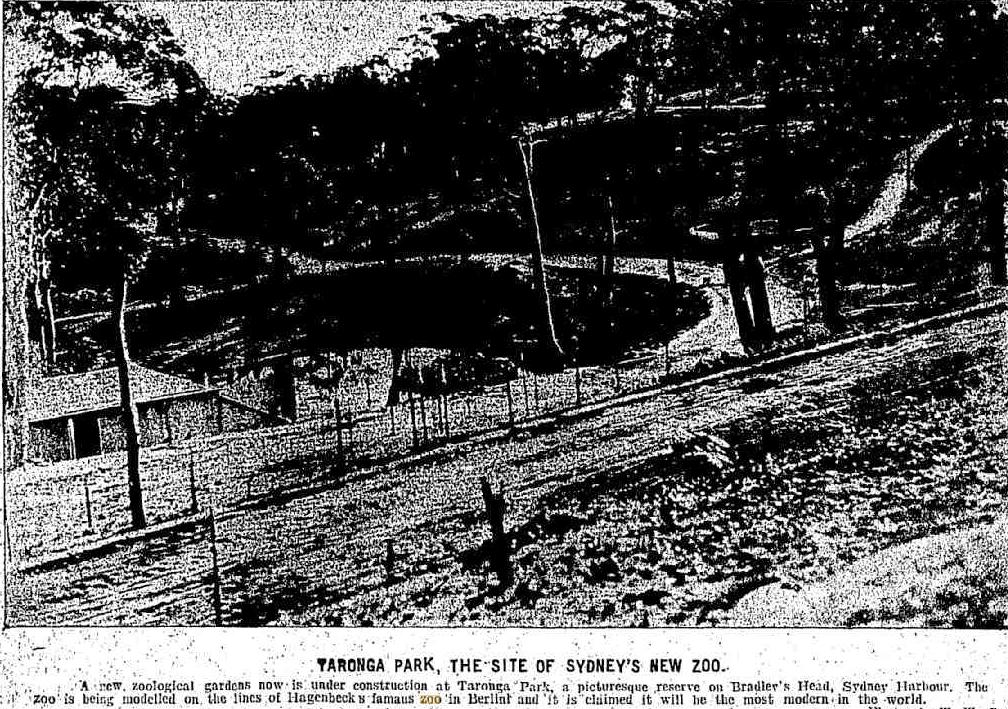
TARONGA PARK, THE SITE OF SYDNEY'S NEW ZOO. (1913, September 13). The Telegraph (Brisbane, Qld. : 1872 - 1947), p. 17 (SECOND EDITION). Retrieved from http://nla.gov.au/nla.news-article175991200
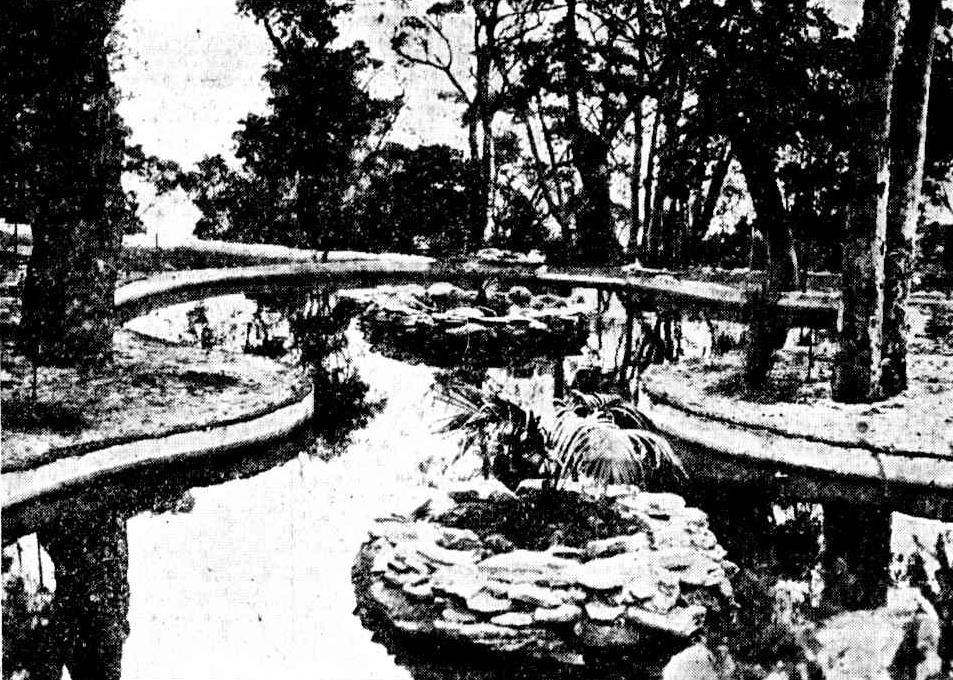
The completed Pond at Taronga Park, Sydney's New Zoo. GENERAL NOTES. (1913, December 15). The Sun (Sydney, NSW : 1910 - 1954), p. 10. Retrieved from http://nla.gov.au/nla.news-article229357413
Soon afterwards the layout of the whole zoo can be seen:
THE NEW ZOO AT BRADLEY'S HEAD.
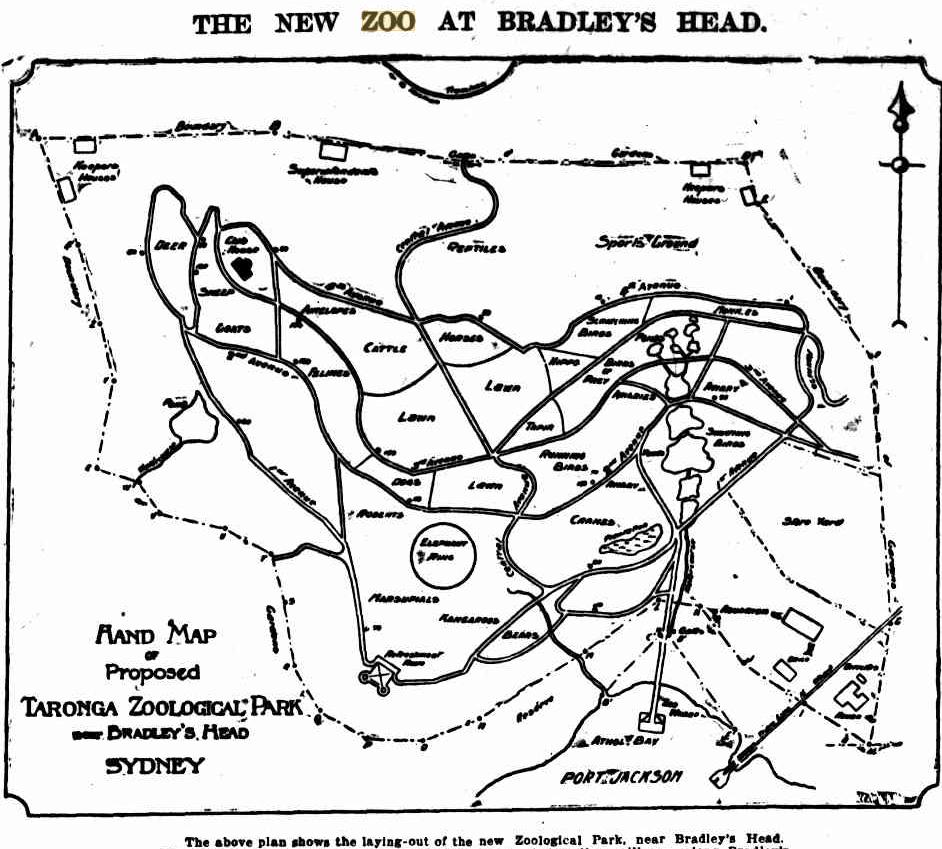
The above plan shows the laying-out of the new Zoological Park, near Bradley's Head.
The area of the, land is approximately fifty acres. A tramline will run along Bradley's Head-road to the top entrance gates, connecting with the Mosman one at the Public school.
There will also be direct steamer communication with Circular Quay. The eastern section of the park is expected to be completed by the end of the present year. Ample provision is allowed for expansion. THE NEW ZOO AT BRADLEY'S HEAD. (1914, January 16). The Sydney Morning Herald(NSW : 1842 - 1954), , p. 6. Retrieved from http://nla.gov.au/nla.news-article15477012
From early in 1916 the moving of the animals from Moore Park to Taronga began with 'Jumbo' the elephant being the first. A Sydney Morning Heraldreport of June 1916 with then President of the Royal Zoological Society of New South Wales, Colonel Alfred Spain V.D., architect and army officer, who visited Pittwater during the Pittwater Regattas of the 1920's era, states the wharf at Athol Bight is being built and Taronga Zoological Park was expected to be opened by June. He also states the meaning of the word 'Taronga' as 'sea view'. :
'JUMBO 'TAKES HIS MORNING DIP AT TARONGA PARK, THE NEW ZOO WHICH IS NOW OPEN TO THE PUBLIC
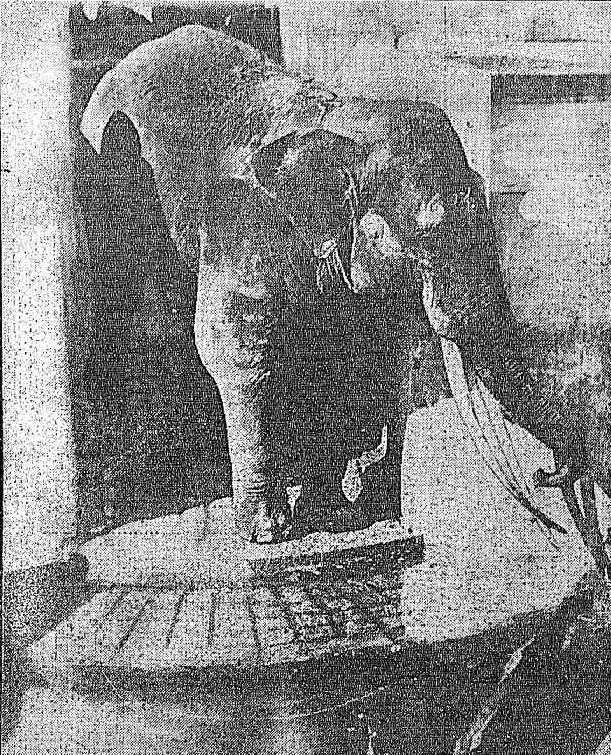
'Jumbo,' who is one of the first of the larger animals to be shifted from the Zoo at Moore Park to the new 'Zoo' at Taronga Park, is here seen going for his morning dip at his new quarters.
Jumbo, who was presented to the Zoo by Messrs. Wirth Bros. of circus fame, has a rather black record against him, having killed three men during his lifetime. The Elephant Home at Taronga Park, which is one of the feature of the new Zoo.
"JUMBO" TAKES HIS MORNING DIP AT HIS NEW HOME AT TARONGA PARK, THE NEW ZOO WHICH IS NOW OPEN TO THE PUBLIC. (1916, February 12). The Mirror of Australia (Sydney, NSW : 1915 - 1917), , p. 16. Retrieved from http://nla.gov.au/nla.news-article104642318
Even a reported escapee and description from later in the year of those along the original route for moving the animals from one side of the city to the other:
IT IS REPORTED that a bull seal has mysteriously disappeared from his quarters at the new Zoo at Taronga Park, and that his friends and guardians are anxiously inquiring for him. When last heard from he was fulfilling an engagement at the old Zoo, at Moore Park. He left his home in Hummock Street, Antarctica, several years ago, and went to Australia for the benefit of his health, on the steamer Buncombe. His subsequent movements are unknown. His sister, Mrs. Bluenose, of No. 1 Icepack Avenue, Antarctica, will be glad to hear from him.
That is the kind of notice that will have to be inserted in the "Daily Howl," the official organ of the Taronga Park Zoo, if he does not turn up shortly, and his disappearance will be productive of a certain amount of justifiable anxiety among residents in the immediate neighborhood of Taronga Park. If a bull seal can mysteriously disappear from his quarters, who can say whether the Royal Bengal tiger may not similarly "do a bunk,'' and whether young lovers walking hand in hand at eve through the shady groves adjoining Taronga Park may not be confronted suddenly by the tufted peccary ("porcus communis"), the guanaco ("monstrum horribile"'), and the great boa-constrictor ("anaconda super-gloriosa")?
The man who has been attending a lodge meeting at Chowder, and who is going home through the bush as steadily as can be expected in the circumstances, may find the bull seal waiting to escort him to his suburban villa, and to lend him the support of a friendly flipper in negotiating the bad bits of the track. On the other band, the weary reveller is just as likely, apparently, to find the hyena bowling the chorus to his masterly rendering of "We Won't Go Home till Mor-hor-ning," or the blue-nosed chimpanzee preparing to dispute his passage with a brick. Until the bull seal reappears, and the mystery of his escape is fathomed, nocturnal revellers will be well advised to give Taronga Park a wide berth. The World's News (1916, July 8). The World's News (Sydney, NSW : 1901 - 1955), p. 14. Retrieved from http://nla.gov.au/nla.news-article130582422
In all, 228 mammals, 552 birds and 64 reptiles were moved from Moore Park to Taronga. Many, including the elephants, crossed the harbour on board a flat top barge. An insight into the move from then:
SYDNEY'S NEW ZOO.
Mournful yells from hyenas, angry roars from lions and tigers; good-humored snorts from gigantic elephants hauling a veritable menagerie of wild beasts confined, in cages, have of late disturbed the early morning serenity of Sydney streets. Dwellers in city flats disturbed from their slumbers by such unusual sounds have drawn the window blinds and looked down on a unique sight.
Never, it is safe to assert, has the city seen such processions of denizens of the Indian jungle; wild roamers of the African veldt and South American Pampas, bears from the Arctic and Canadian Rockies, stately ostriches, kangaroos, screeching parrots from Peru and the Australian bush; ungainly crocodiles lashed on to lorries by ropes, and hundreds of other animals calculated to induce a bad attack of nightmare. Those persons whose business takes them out on the streets at such an early hour who have been curious enough to follow the cortege to the eastern bank of Circular Quay have been interested to see the procession embark on a miniature Noah's Ark, in the shape of a "horse" ferry, for the north side of the harbor,
Seldom since the time of Noah has the old ditty:
The animals walked on two by two,
The elephant and the kangaroo,
been better exemplified. Arriving on North Shore the animals have resulted their journey to the accompaniment of an intensified babel. Within an hour they have been ushered into an environment which will be of immense benefit to them: Sydney's new Zoo, at Taronga Park, situated on the neck of that magnificently wooded promontory, Bradley's Head.
For thirty-five years Sydney's Zoo has been located at Moore Park, adjacent to the Sydney cricket ground and the Royal Agricultural show ground. 'The area has for many years been too small for the valuable collection of animals gathered the Zoological Society. Its location has not been such as to recommend it from the point of view of the critical tourist. No more will Sydney's Zoo suffer, by comparison with that of Melbourne. In 'Taronga' it possesses something which easily eclipses anything in the way of Zoological Gardens, Australia, and in fact, most of the big cities of the world, have ever possessed.
For the first time since 1879 the Government has taken charge and expended sufficient money to provide the city with something that will advertise it over the length and breadth of the globe. Just what the cost has been the Premier seems disinclined to state. To Mr. Le Souef the well-known zoological expert, must be granted the credit of planning the new area. He did it after a world tour, and introduced all the latest improvements that the zoological gardens of Europe and America could suggest. . In providing a Government reserve of 61 acres on the neck of Bradley’s Head, the State Ministry presented a site which cannot he rivaled anywhere in the world. Virgin forest still claims this historic promontory.
The Zoo buildings have not disturbed the natural features of .the place. There are no formal cages in which the beasts are immured. The huge sandstone boulders and rocks which nature has distributed on the headland have been utilised as homes for the animals by judicious cavern building. They remain to show nature undisturbed. Natural beauties have been supplemented by artistically contrived artificial rocks, waterfalls, terraces and lakelets. The animals roam at large, separated from the visiting public by moats, the outer edge of which are raised breast high. At first the visitor gets quite an uneasy feeling to see three or four lions roaming amidst the rocks unrestrained by bars and bolts. His thoughts fly back to the stories of his youth, and uncomfortably he recalls the thrilling leaps of wild animals he has read about in books of adventure. It seems only a hop, skip and a jump to where these wild beasts glare at him with rolling eyes and yawning jaws. Then he gains comfort by information that the moat is 28 feet; wide, and there, is no take off to give the impetus for the prodigious springs generally attributed to animals of the feline species. Mr. Le Souef calms all -feeling of apprehension by stating that no lion or tiger has ever been known to jump more than 18 feet in length and 10 feet in height. The elephants live in a sort of citadel, surrounded by a moat. They are provided with a huge bath, in which they delight to disport themselves. One his to keep at a distance however, to escape the edges of the shower baths they give themselves with their trunks. One elephant has lately run what Kipling calls "musht," and has given considerable trouble in his new surroundings. Quite recently a lady, sitting in a little alcove on the right side of the elephants' moat, admiring the panorama of the harbor below, had her new spring hat torn from her head, and looked round to find the elephant waving it triumphantly in his trunk. That alcove has now been fenced off, and the wildest effort of the elephant cannot bring him into contact with the onlookers. Most of the birds, monkeys and antelopes are happy in their new quarters. Monkeys swing from native trees, parrots fly in huge wire netting enclosures, also containing natural trees. The official opening of the new Zoo has been fixed for 7th, October, but it will be nearly Christmas before the final changes are made.
SYDNEY'S NEW ZOO. (1916, October 7).Leader (Melbourne, Vic. : 1862 - 1918), , p. 51 (WEEKLY). Retrieved from http://nla.gov.au/nla.news-article89767018
REMOVAL OF THE ANIMALS FROM THE OLD SYDNEY ZOO TO THEIR NEW QUARTERS AT TARONGA PARK.
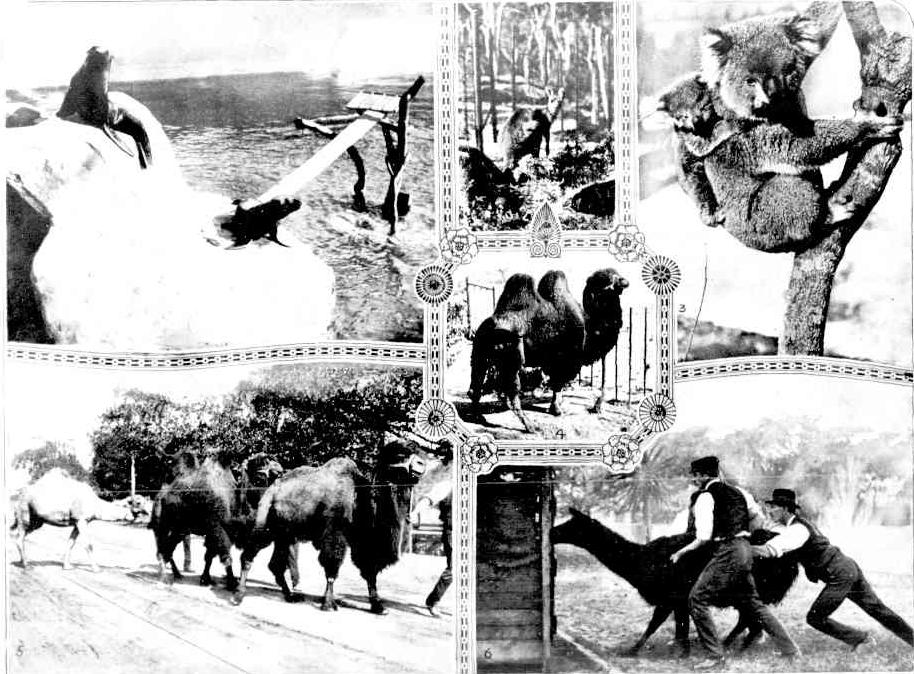
1, SEALS IN THEIR EXTENSIVE POND, STUDDED WITH IMITATION ICEBERGS. 2. THE KANGAROO COMES INTO HIS OWN BIT OF COUNTRY. 8. MOTHER AND BABY BEAR IN THEIR NEW HOME. 6. CAMELS ON THE ROAD. 4. ENJOYING THE OUTLOOK. 0. PUTTING THE LLAMA INTO THE MOVING BOX. REMOVAL OF THE ANIMALS FROM THE OLD SYDNEY ZOO TO THEIR NEW QUARTERS AT TARONGA PARK. (1916, September 16). The Australasian (Melbourne, Vic. : 1864 - 1946), p. 58. Retrieved from http://nla.gov.au/nla.news-article140698409
The first visitors encouraged to visit the new zoo were schoolchildren:
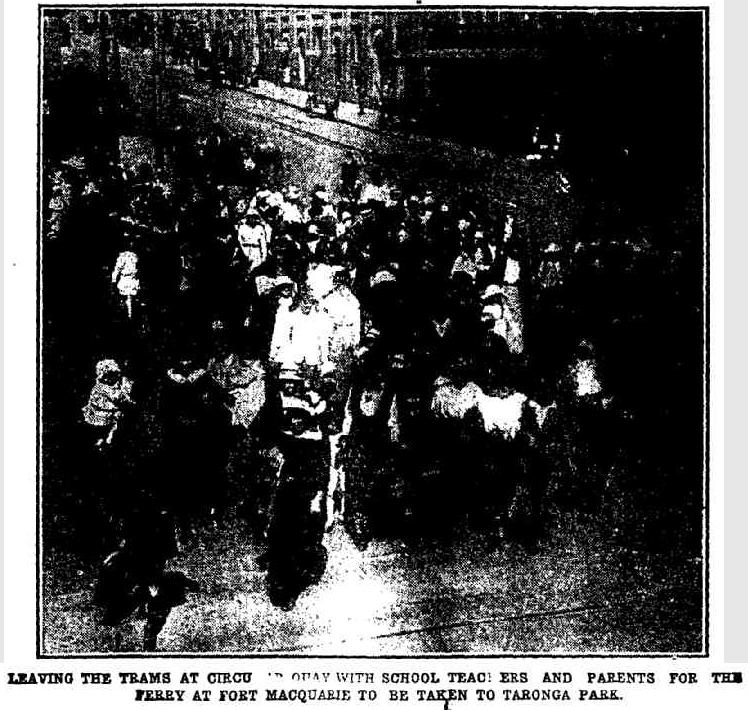
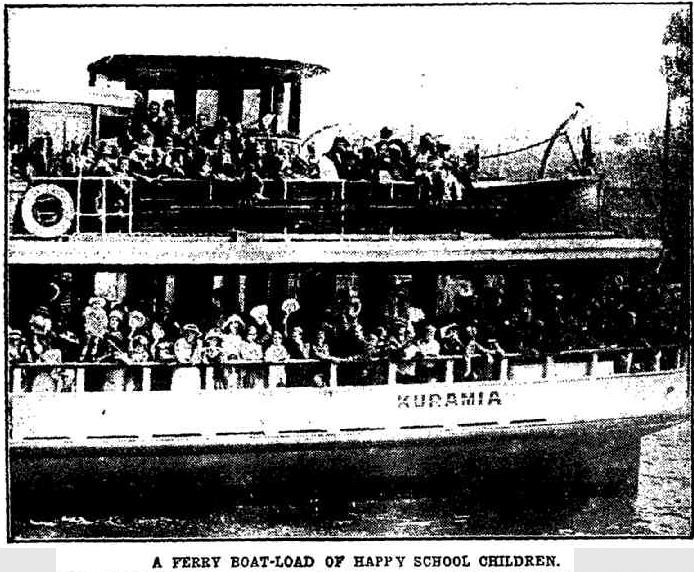
ON THE WAY TO THE NEW ZOO ACROSS THE HARBOR. ON THE WAY TO THE NEW ZOO ACROSS THE HARBOR. (1916, September 11).Evening News (Sydney, NSW : 1869 - 1931), p. 3. Retrieved from http://nla.gov.au/nla.news-article120370333
HAPPY HEARTED YOUNG AUSTRALIANS VISIT THEIR NEW PLAYGROUND AT TARONGA PARK.
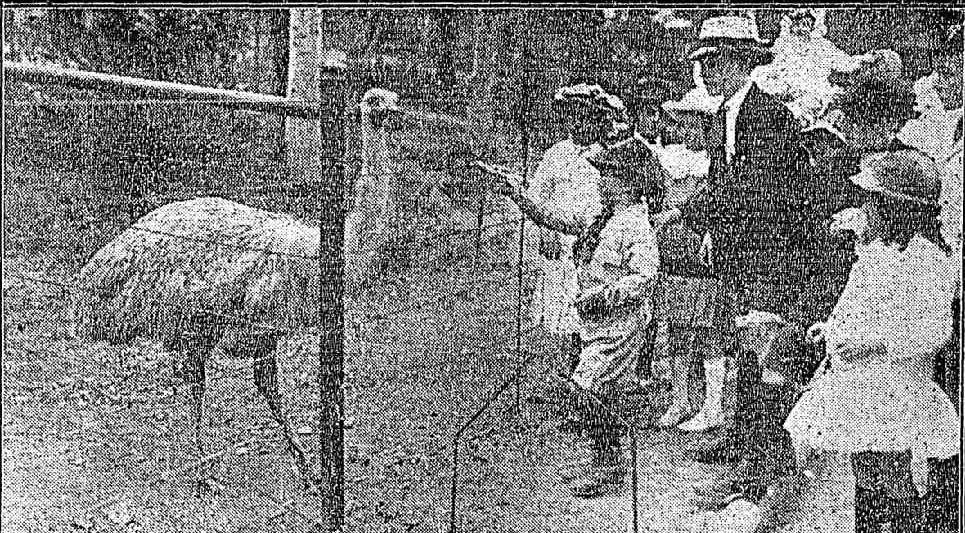
Children's excursions to the new Zoo at Taronga Park, Sydney, have been continued all this week.' Our photo shows the Emu receiving an Arnott biscuit from the hand of a rather diffident small boy.— (Special 'Mirror' photo.). HAPPY-HEARTED YOUNG AUSTRALIANS VISIT THEIR NEW PLAYGROUND AT TARONGA PARK. (1916, September 23).The Mirror of Australia (Sydney, NSW : 1915 - 1917), p. 16. Retrieved fromhttp://nla.gov.au/nla.news-article105137728
AN IDEAL ZOO
TRANSFORMATION HOW IT WAS EFFECTED ; Mr. Flowers' Great Part :
TARONGA PARK
NEW PLEASURE GROUND
Long Wanted Change
On Saturday, October 7, the new Zoological Gardens at Taronga Park will be formally opened by the State Premier. The story of the transition from the old quarters to the new may be best told by Mr. Flowers, the President of the Legislative Council, and chairman of the Zoological Trust.
'It was somewhere about 1911,' he says, shortly after the present Party came into power, that Mr. Hoyle and myself were appointed to the old Zoological Council. I was then Chief Secretary, and Mr. Hoyle represented the district concerned. Both of us from the outset were imbued with the one idea of shifting the site of the gardens. The conditions prevailing then were scandalous, and the place was little short of a public nuisance. As for the housing of the animals, it practically amounted to inhumanity. 'The matter had been frequently discussed beforehand, and there was no question as to the desirability of shifting the site. But no practical steps had been taken to bring this about. At the first meeting Mr. Hoyle and I attended we explained our object, and immediately we began to look for other sites. A number were on offer, but finally that at Taronga Park was decided upon as being the most suitable for all the purposes we had in view.
'When matters had reached this point it was thought advisable to form a trust to take over the control of the undertaking, independent of the workings of the Zoological Society. The original nominees of the latter to the trust were Colonel Spain, Mr. W. J. Green, Dr. R. H. Todd, Mr. Albert Nash, Mr. Hoyle (then simply M.L.A.), Mr. Chas. Hedley, F.L.S.. and myself. These were gazetted by the Minister for Lands, and I was elected chairman. 'We had a little money in hand to work with, and together with other amounts that were furnished from time to time, we started work ourselves. But we soon found it necessary to enlarge the trust, and Mr. Davis, the director of Public Works, Mr. Smail, of the Water Board, and Mr. Keele, of the Harbor Trust, were added. These three brought to the task the special experience and knowledge of their own crafts assets that have proved invaluable. Not that the original members of the trust had not his own special value; but the task we had set out to accomplish was essentially one that demanded in large part the assistance of three such men with their qualifications.
''Even so, we began to find that the work was too heavy for us, and finally the job was taken over by the Public Works Department. That, in outline, is the story of the new Zoo, but I cannot leave it at that. From the beginning my colleague (Mr. Hoyle) threw himself into the work with wonderful energy, and has never ceased to take an active and practical interest in all our doings. Then there is the Premier himself. During the last two years Mr. Holman .,' has taken a keen and personal interest in 'every-thing that has engaged our attention. It is safe to say that had it not been for his advice, and encouragement matters would not be so far advanced as they are to-day.
'It is our belief that we are on the eve of giving the people of Sydney the finest pleasure ground in Australia. It is our hope that in the near future we shall be giving the people of Australia the finest Zoological Gardens in the world. We have done this for the people, and it is now for them to prove worthy of the effort by helping us to preserve the grounds in good order. It is within the power of the careless visitor to do irreparable harm to the grounds, and therefore I would urge upon all who would visit the place to bear in mind that what they see is their own care, and worthy of the respect they would accord their own property.'
The shifting of the Zoological Gardens to the new quarters at Taronga Park has brought joy to the hearts of the animals themselves, to the hearts of the general public, and to the hearts of those officially connected with the institution. It is a joy long awaited and over-long due. To view the new site of the gardens and to cast back the memory to the old quarters is to wonder how the latter were tolerated so long. Under the most difficult conditions the staff labored day and night to make a presentable showing with the really fine collection of animals in their keeping, only to achieve no greater success than might be obtained In a decent circus menagerie. In the recent past a visit to the Zoo was a penance rather than a pleasure. To-day it is a pleasure to be indulged in at frequent intervals, and each visit will reveal fresh beauties and afford fresh lessons. To convey an adequate idea of the beauties of the Taronga Park site would be difficult.
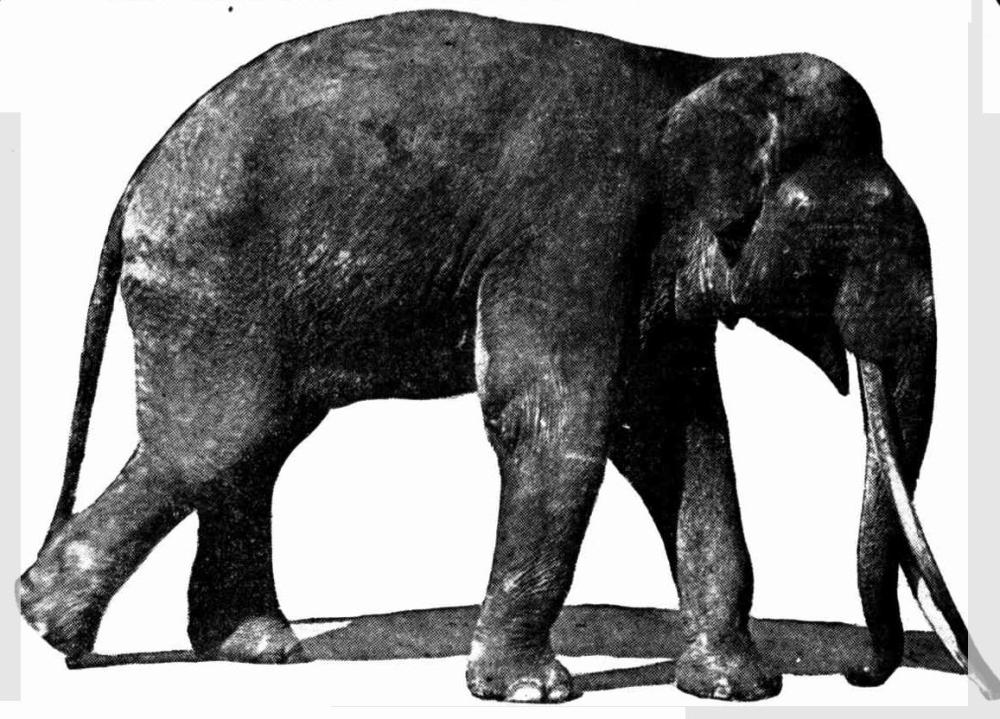
The approach from the water side is bound to be the most popular. The only fault is that the trip is all too short — a matter of no more than twenty minutes or so. Even before Cremorne Point is reached the dome of the main entrance building on the Mosman side is to be seen gleaming in the sun, and then the rock formations of the lion's quarters catch the eye. After that glimpses are caught of the minor features which whet the appetite for a closer inspection. There is no pretentious showing of man's handiwork anywhere, for the idea has been to preserve the natural features of the landscape as far as possible and adapt the requirements as to the housing of the animals and birds to the prevailing rock and tree formations. From the wharf access is gained to the various exhibits by a series of graded paths and tracks cut through the trees and undergrowth. At every step fresh beauties are unveiled, and from the summit of the slope an unrivalled view of the harbor is obtained. The native trees and bushes have been specially cared for, and already the waratahs and Hardenbergia are gleaming with their red and purples. In a few weeks the place will ' be aglow with colors. Palms and other exotics have been skilfully introduced into the general scheme, whilst turf lawns and embankments will soon make their call to weary feet. Even in its present unfinished state the place appeals remarkably.
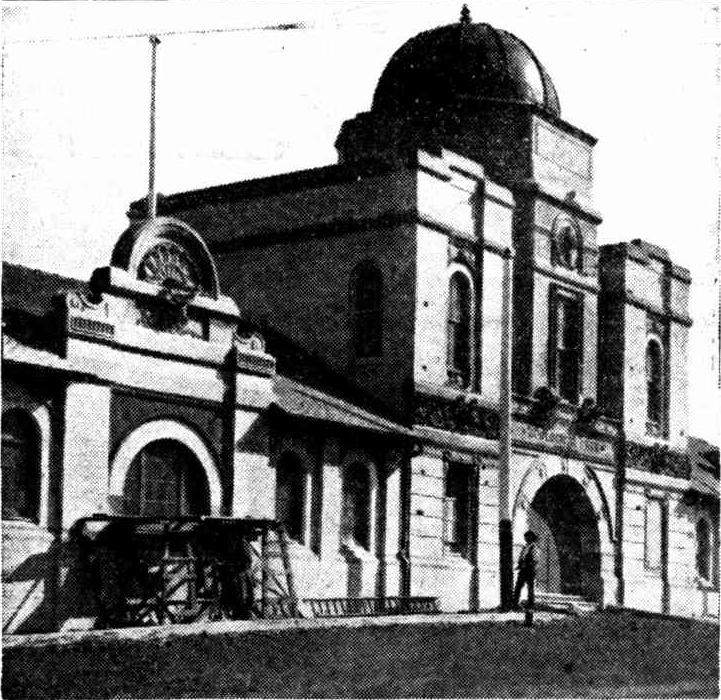
THE MAIN ENTRANCE ON MOSMAN SIDE
NATURE REAL AND SIMULATED.
The scheme adopted for the housing of the animals is modelled on Continental and American practice. Iron bars and wooden walls have been cast into the discard, and the first impression gained from the changed aspect of affairs is the more humane treatment afforded the animals. The spectacle of caged lions and tigers was always an offence, somehow, though for the layman there seemed no way out of the difficulty. The problem has been solved in simple fashion. The fiercest lion or tiger imaginable cannot leap more than a certain distance, more than a certain height. Provided, then, that he is surrounded by a ditch that is wide enough and a wall that is sufficiently high, he may be considered safely housed from the point of view of the spectator. That is what has been done at Taronga. The photo shown herewith explains the manner of its doing. It also illustrates the fashion in which the natural environment of the animals has been, as nearly as may be, reproduced. To think of a lion is to conjure up a picture of some rock-bound lair on the ridge of a sun-drenched hill, and that is the picture that now meets the eye. Where the rock in situ has not been adequate for the purpose, concrete has made up the deficiency. The manner in which Nature has been simulated is remarkable. The finished product is practically undetectable from the real article, and when the weathering has gone a little further the dummy article will have to be labelled if it is desired to differentiate it. Upon a framework of iron rods and wire, any desired formation may be built up by application of a concrete plaster. As to the stability and security of these constructions there can be no question. The lions' dens, the bear pits, and the monkey reservations have all been built up in this fashion. But perhaps the best illustration of the method is to be seen in the seal tanks and ponds. Here we have iceberg and icefloe formations imitated with an attention to detail that' must deceive the occupants themselves. At any rate, they have already made themselves quite at home in their new quarters, and seem to be looking forward to a permanent residence there. In the monkey pits there are' such space and such facilities for impish mischief as the occupants never dreamed of in their last homes. There they were amusing enough in .ill conscience. Here the spectator derives fresh amusement from the very obvious expression of a non-plussed state of mind that the inhabitants bear. They miss the bars as much as we do, and fail to see just why it is that they are not so free as they seem.
THE ELEPHANT HOUSE
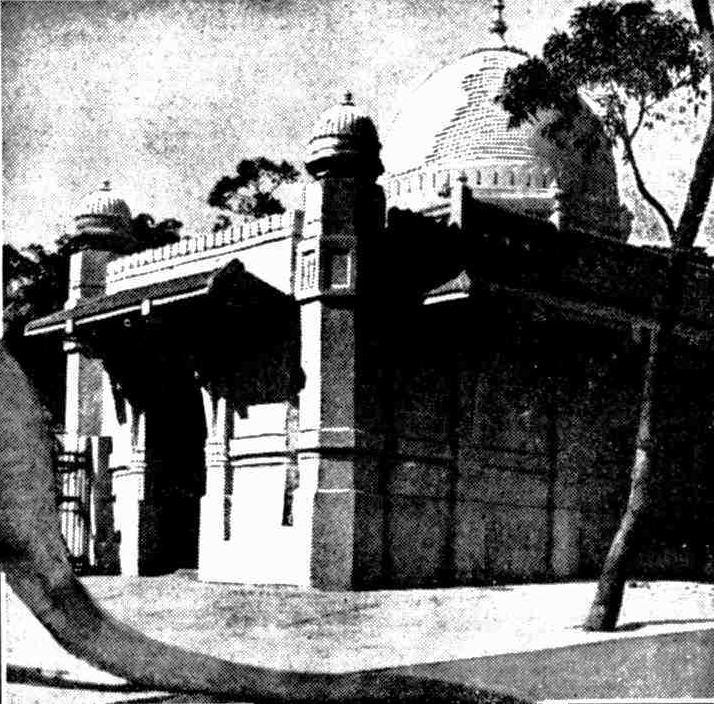
This is one of the features of the new grounds. The Eastern effect of the buildings may be appreciated from the photo. The courtyard is surrounded by a deep ditch beyond which the inmates cannot go.
AN OLD RESIDENT.
My Lord, the Elephant, has a home all to himself just now. It is quite an oriental palace in its way, with its dome and fretted stucco-work. The imagination is brought nearer home by the sight of the slender gum tree in the courtyard. Surrounded by the ditch to the limits of which his trunk-tip barely reaches, he sways his bulk on padding feet exacting the tribute of fruit and buns that is ever waiting him from the constant throng of youngsters. He, too, appreciates the beauties of his new home, and by reason of his long residence there already, is inclined to lord it over the rest of his fellows. And he carries it off well. The animal that spits is not yet in residence, and his coming will surely be an event with patrons. Once he arrives it will not be long before the ingenious infant has tested the truth of the label at the expense of an unsuspecting parent. But the next best thing is on view. The two camels are looking very well, and conscious of the memories they recall of a time long ago, when certain of the nations now fighting side by side were not so friendly. They were a gift to the local authorities from the then Emperor of Japan, whence at that time the latter and his people were at war with Russia. A convoy of camels was captured during the campaign, and these two specimens were amongst them. They constitute a token of esteem and regard which any zoo would be glad to accept and house.
If it is a pleasure to see the lion accommodated in natural quarters it is no less a delight to see the various specimens of our native fauna at home in the native surroundings. Somehow the wallabies and the 'roos look more what they really are and less like book illustrations. This does not apply to the native bear, which still looks as if it had just been drawn by Norman Lindsay. The bird cages are cages in name only, there is so much room and light. The constructors have in this connection gone as near to attaining their ideal as could well be expected. For the success of the scheme, Mr. Le Soeuf, the Director of the Gardens, has been largely responsible. The actual planning of the new site was chiefly his work, his own, matured ideas having been fortified and enlarged by a special trip to Europe and America, where he saw the best and latest institutions of a similar nature. AN IDEAL ZOO (1916, September 17).Sunday Times (Sydney, NSW : 1895 - 1930), , p. 19. Retrieved from http://nla.gov.au/nla.news-article121337261
A description of the opening day festivities:
NEW ZOO OPENED THIS AFTERNOON
There was a large concourse of people present this afternoon to participate in the official opening by the Premier, Mr. W. A. Holman of the new Zoological Gardens at Taronga Park, Mosman. Admission was by invitation only, and special steamers were provided to convey visitors from Circular Quay to Cremorne, where other special trams completed the Journey to the zoo. Several hundreds gathered round the dais at the gate, which was gaily decked with garlands and flags— from which the Premier formally declared the gardens open.
Entrance was then made, and after the visitors had partaken of afternoon tea and listened to the R.S.A. Band, an inspection was made of the grounds and the zoological collection they contain. Special steamers and trams conveyed visitors home. NEW ZOO OPENED THIS AFTERNOON. (1916, October 7). Evening News (Sydney, NSW : 1869 - 1931), p. 4. Retrieved from http://nla.gov.au/nla.news-article114377328
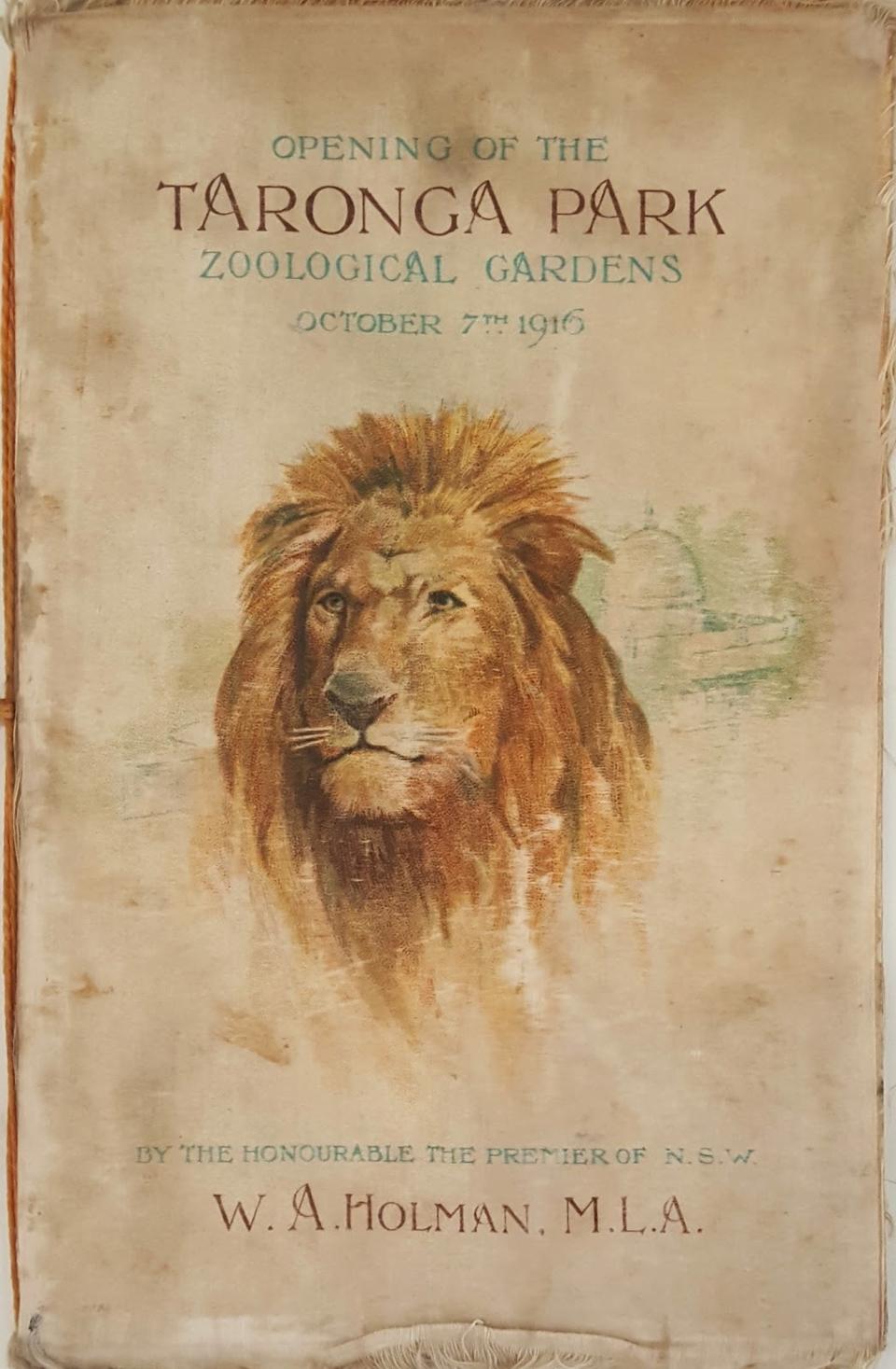
Itinerary booklet produced for the opening of the Taronga Park Zoo, by the Premier of N.S.W., W.A. Holman, 1916, State Library of New South Wales, 590.7449441
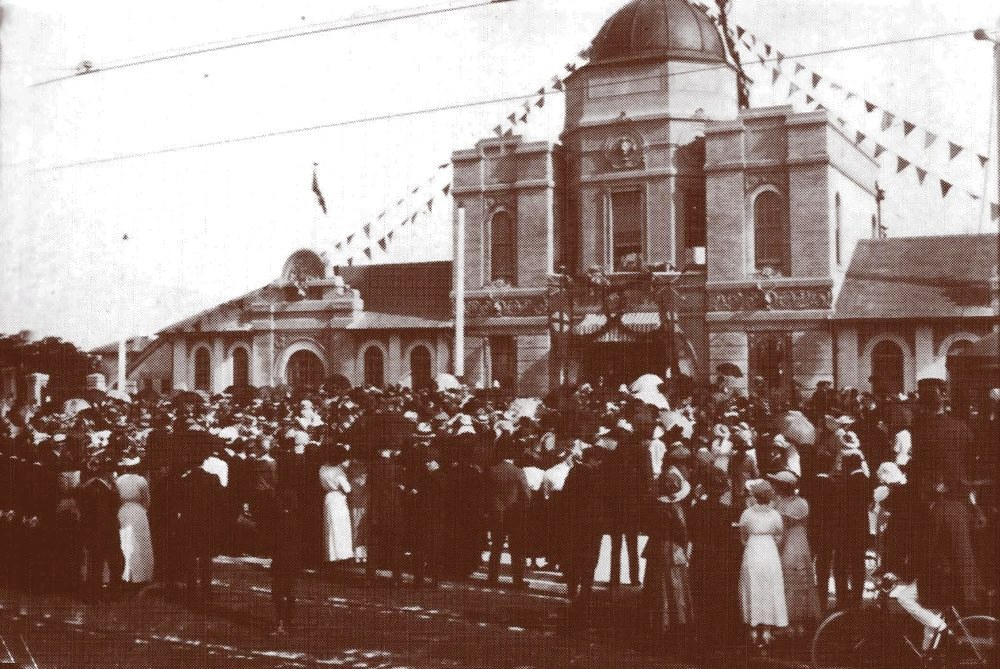
Taronga Zoo Opening Day, October 7th, 1916
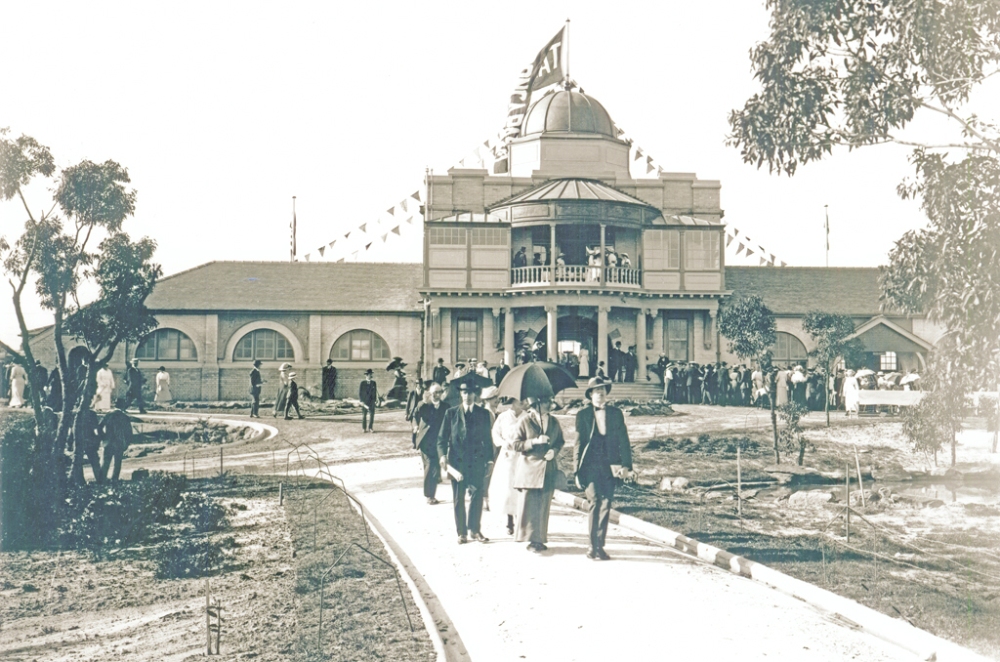
The facade of the Main Entrance building in 1916
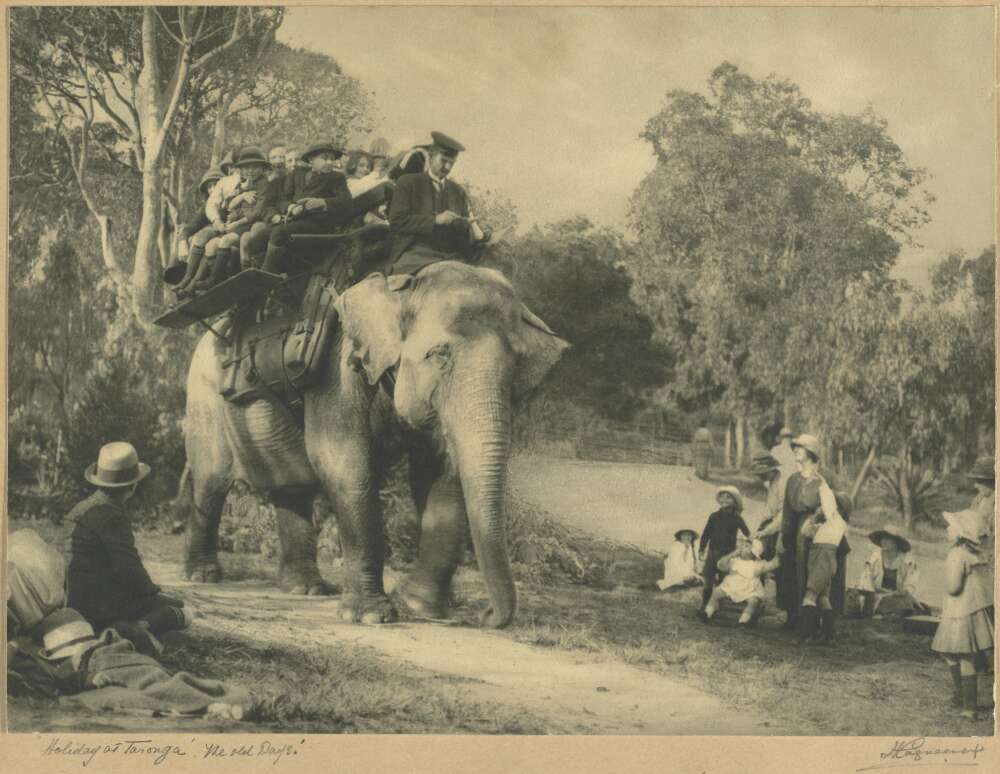
Holiday at Taronga [picture] : the old days by Harold Cazneaux - 1922 - courtesy National Library of Australia. Image No.: PIC/8893/133
Once open Taronga became the place to go
WHERE TO GO ON SUNDAY SYDNEY FERRIES BIG TRIP
'Your ocean beaches are magnificent. I can understand why thousands throng them on Sundays and holidays. But give me this.' The remark was uttered recently by, a visitor to Sydney who, having rambled- up a hillside on the northern foreshores of the Harbor, was reclining in a glassy, glade, laced overhead with greenery, its open side vignetting a magnificent panorama of cliff-head and beach and harbor, and the sweeping curves of the distant southern foreshores. Within the view unsurpassed and re-paused yachts, with their snowy white sails bellying in the breeze ; quickly moving ferry-boats drawing the white lines of their wakes across the Harbor's blue; big ocean-going steamers with foaming wave-curls at bow; jaunty little tugs; work-stained colliers. It was like watching a cinematograph picture, in such silence was the active scene presented, so peacefully quiet the glade. Only the multiplied frou-frou of the little waves dashing up against the silver crescent beach below broke the stillness.
THE ZOO.
The setting views are typical of a hundred other spots around the northern foreshores. They are ideal resorts for people tired of the crowded, noisy promenades into which the ocean beaches are converted on Sundays and holidays; for those who believe that the best holiday after a hard week's work — whether the work has been in office or home — is quiet enjoyment. A swim away from the dreaded undertow, a lounge on any unthronged sunlit beach, an al fresco luncheon in the cool shadows of a secluded glade, a hunt for wild flowers in unfrequented places, where are rival pleasures ? All these holiday pleasures, and more, are provided in the four harbor pleasure resorts that have been linked up by the Sydney Ferries, Ltd., in one big ferry service that takes in also the New Zoo at Taronga Park. Of the Zoo little need be said. It always will be a children's paradise.
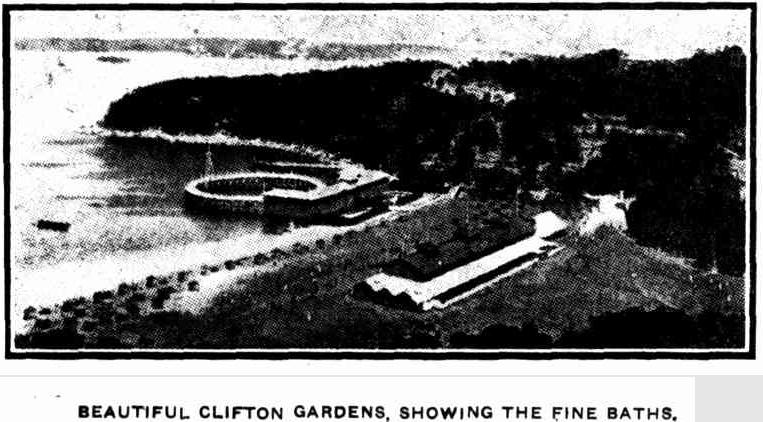
BEAUTIFUL CLIFTON GARDENS, SHOWING THE FINE BATHS.
Taronga Park has been designed on the very latest lines, and the wild animals are not caged behind iron bars, although they are equally surely prisoned within ditches and moats. To walk along a path and suddenly see a lion or a tiger or a leopard calmly surveying you from just across the way, and to be able to discern no protecting obstacle, may be a little disconcerting at first. But when you are shown the deep ditch and unclimbable walls that surround the eminence from which the animal has looked out upon an unattainable meal of many courses, you can enjoy the glamor of the strange surroundings and the thrilling naturalness of the setting. There is, of course, a howdah-saddled elephant waiting to be ridden, all kinds of other wild animals and rare birds, and a fish aquarium. The park with its pretty landscape garden scenes is dotted with kiosks and well supplied with refreshment rooms.
WHERE ALL SYDNEY COULD HIDE.
But the Zoo is only the first stopping-place on the big trip. Beyond are the quiet beaches, the spacious bushlands and bowered hillsides of Athol Gardens, Clifton Gardens, Neilsen Park, and Balmoral. Each one of these places could hold a big proportion of all the holiday-, makers of the metropolis and not be crowded. With the five to divide up the biggest throng, any person could easily find for himself or' his party places of absolute seclusion. The variety of pleasure is unlimited. To mention a few, there, arc swimming, boating, paddling, picnicking, sun-baking, bush rambles, wildflower gathering, cosy bush corners, magnificent scenic outlooks, fishing. At Clifton Gardens there are splendid, commodious, up-to-date swimming baths with a great diving tower, and two semi-circular bathing enclosures; a long curving beach set into a towering amphitheatre of bush-covered hills; a -broad grassed stretch of level park dotted with ornamental kiosks ( each of which is fitted with a table and seats for the convenience of picnic parties), refreshment rooms, and special facilities for providing boiling water for tea-making and other, purposes. The hillsides arc a glory of foliage and wild flowers. At Athol Gardens, Nielsen Park, and Balmoral Beach, there are similar arrangements for holidays makers. At two places. Clifton and Balmoral, swings and round-abouts are available for the children. Easily accessible are also hundreds of tiny half-hidden coves that seem to have been designed by Nature almost on the one-to-a-family plan. And at the back of these beaches are all sorts of - bush nooks and corners.
SURF BATHING, TOO.
Balmoral not only has its enclosed baths and similarly beautiful surroundings, but it actually has surf-bathing. It may seem far stretched to talk of surfing in the harbor. Balmoral Beach, however, faces the opening between the Heads, of which an imposing view is obtained, and through the entrance sweep great ocean rollers to foam up on the beach. Neilsen Park is portion of the historic Wentworth Estate, and is fronted by one of the most perfect of the harbor beaches. The Park itself is one leafy bower. . To make the trip around these places, without landing, is inspiring. It is a journey of about 16 miles skirting the beautiful foreshores of the harbor. The steamer turns into deep half-hidden bays, where silver beaches nestle under steeply rising hill: The Sydney Ferries' fastest and biggest steamers arc engaged in this Sunday and Holiday Service, and as they speed along they whip the. water-cooled air of the harbor into great refreshing breezes. They dodge through fleets of graceful ' sailing boats, past other speeding ferry boats ana unroll before their passengers a constantly changing panorama of noiseless life and' activity. It is a revolutionary change from the discomforts of tightly packed trams screeching noisily along and raising clouds of dust ; from the sooty interiors of roaring rattling trains ; even from the overcrowded ocean beaches where everyone is talking at the same time and the sounds are like unto the babel of a few dozen I.W.W. orators having a vocal competition. Particulars of to-day's fares and trips will be found in our advertisement columns. HARBOR BEAUTY SPOTS (1916, October 15). Sunday Times (Sydney, NSW : 1895 - 1930), , p. 23. Retrieved from http://nla.gov.au/nla.news-article121346420
Taronga has been a reflection of what was happening elsewhere as much as our aspirations to save animals through education. The 'General Strike' of 1917, in response to a drop of wages and introduction of a 'card system' of time and motion study, a bit Big Brother-ish and during the years when Russia was going 'red', saw waterside workers replaced by strikebreakers who were housed at Taronga.
One paper, in proving media or its owners have long been supporting political agendas, for close to 100 years in this instance, shows us some of these gentlemen and how it was considered unreasonable by some to protest against your own family going hungry, or scrutiny which impinged upon your own rights, during times of war. All this under the above mentioned, and until 1916 Conscription, former Labor politician and soon to be Nationalist Premier of NSW, William Holman:
LOYALISTS AT TARONGA PARK.
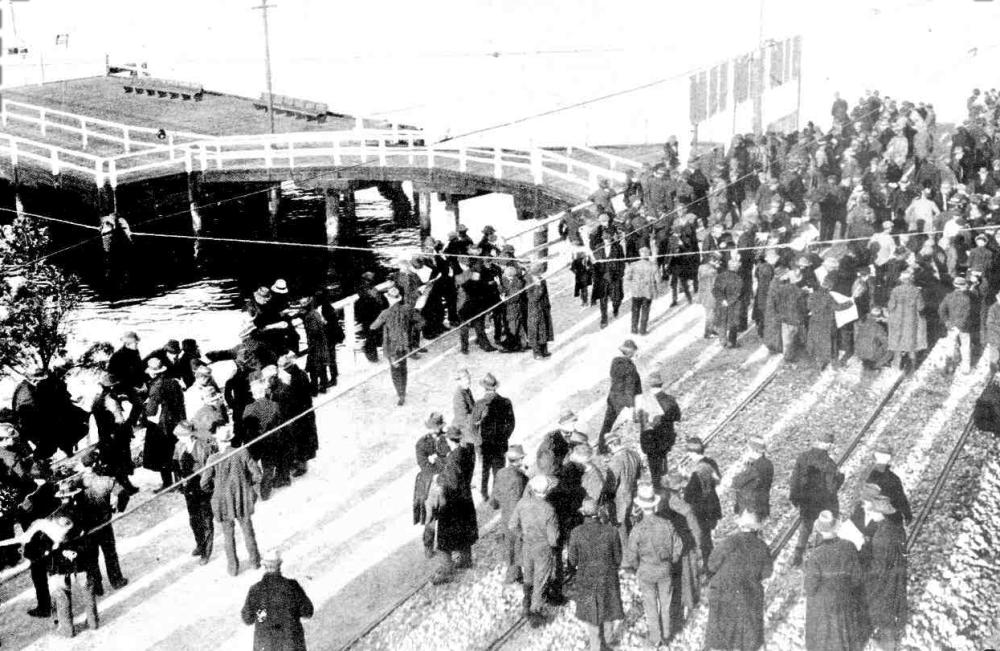
The volunteer waterside workers are drawn chiefly from the camp at Taronga Park. Our picture shows some of them waiting at the wharf for instructions concerning their day's tasks, to which they are conveyed in launches, journeying to and from the park these launches receive a good deal of attention from passengers on the ferry boats, who heartily cheer the stalwart men that have come from the country districts to replace the strikers. The camp at Taronga Park was established under the direction of Colonel Spain, V.D., and the volunteers express the utmost satisfaction with what has been done for them. The loyalists camped at Taronga Park, the Cricket Ground, and the Abattoirs have decided to present a battleplan to the Imperial army for service in the war, as a commemoration of the service upon which they have themselves been engaged during the past few weeks. LOYALISTS AT TARONGA PARK. (1917, September 19). Sydney Mail (NSW : 1912 - 1938), p. 14. Retrieved from http://nla.gov.au/nla.news-article160629908
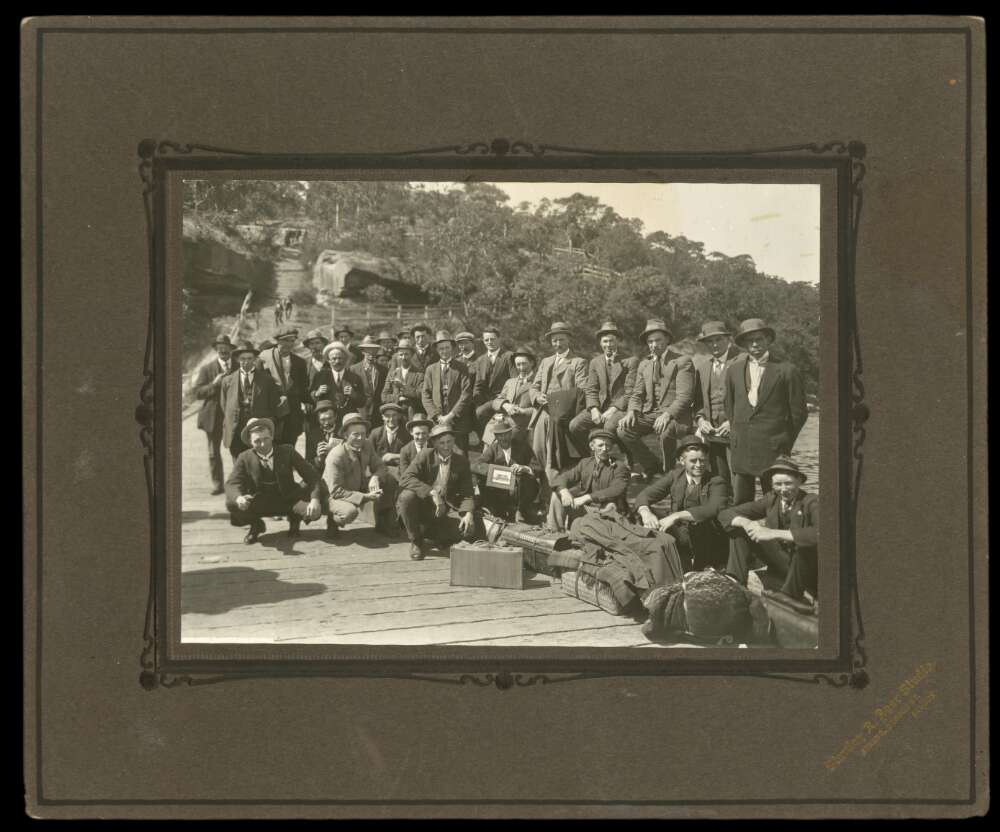
Strike-breakers on Taronga Wharf, Sydney, 1917 [picture] / by Stanley R. Beer Studio. Courtesy National Library of Australia. Image No.: PIC/8721/2 LOC Box PIC/8721
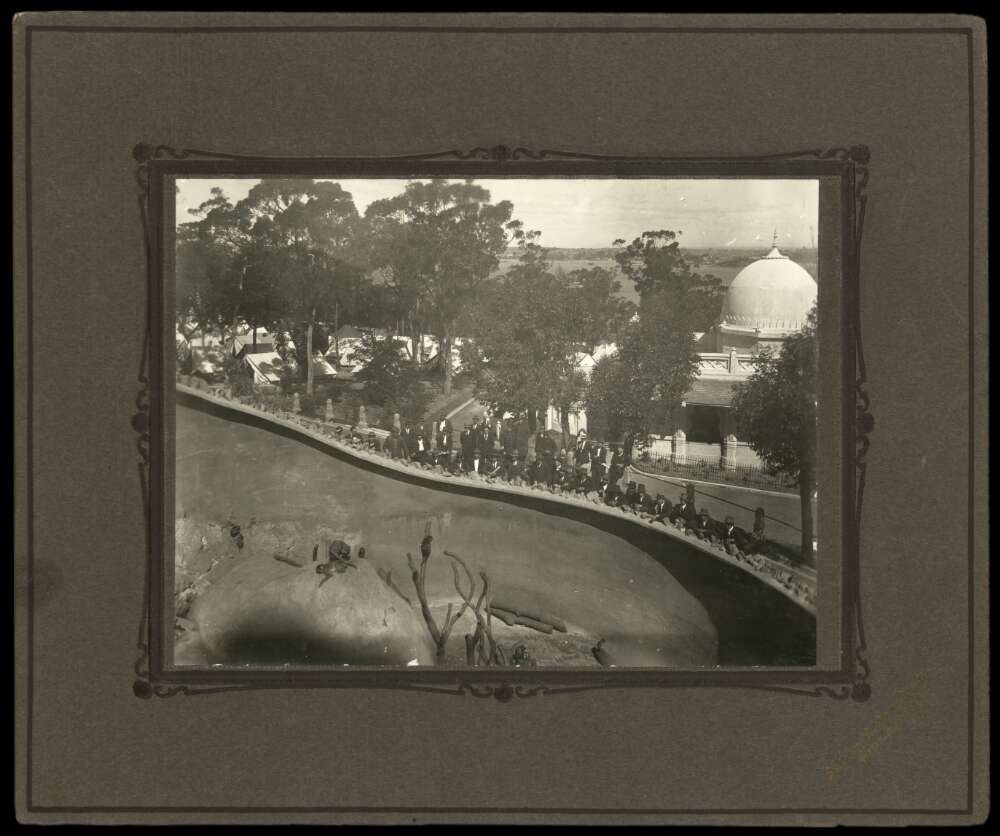
Strike-breakers and tents at Taronga Zoo, Sydney, 1917 [picture] / Stanley R. Beer Studio. Courtesy National Library of Australia. Image No.: PIC/8721/1 LOC Box PIC/8721
THE ZOO PARK TO BE RE-OPENED
For a number of weeks past the Zoo at Taronga Park has been closed to the public, but the place is to be re-opened to-morrow. The new tramway from the wharf to the upper entrance gates will then be available, and this will give visitors an easy down-hill walk through the park instead of the former steep climb from the waterside. THE ZOO PARK TO BE RE-OPENED (1917, October 26). The Sun (Sydney, NSW : 1910 - 1954), , p. 7 (FINAL EXTRA). Retrieved from http://nla.gov.au/nla.news-article221406061
SYDNEY ZOO
Taronga Park Site PROGRESS MADE SYDNEY, Monday.
Mr. H. B. Brown, secretary and administrative officer of the Taronga Park Trust, has just completed 20 years' service. He states that great progress has been made In the Sydney Zoo since Its transfer from Moore Park to Its present site.
The transfer was made in 1916. Colonel Alfred Spain, the present chairman of the trust, was a member of the committee of three which selected the Taronga Park location. Mr. Brown yesterday said that Colonel Spain's administrative ability and professional knowledge were largely responsible for the remarkable progress made by the Zoo during the past 20 years.
Among the present exhibits at the Zoo, only one, Jessie the elephant, came from Moore Park. Jessie is 65 years old, and was still probably the most popular attraction of the Zoo. There are now about 500 animals and 3500 birds at Taronga Park, and Mr. Brown told of the tremendous task of providing modern accommodation for them, and at the same time transforming the area Into a garden, which rivals tho Botanic Gardens for beauty. The monkey pit and the lion pit, he said, were the largest of their kind in the world. The aquarium, opened in 1927, was described recently by Professor Dakin as second only to the John Shedd Aquarium In Chicago. Last year It was visited by 218,000 people.
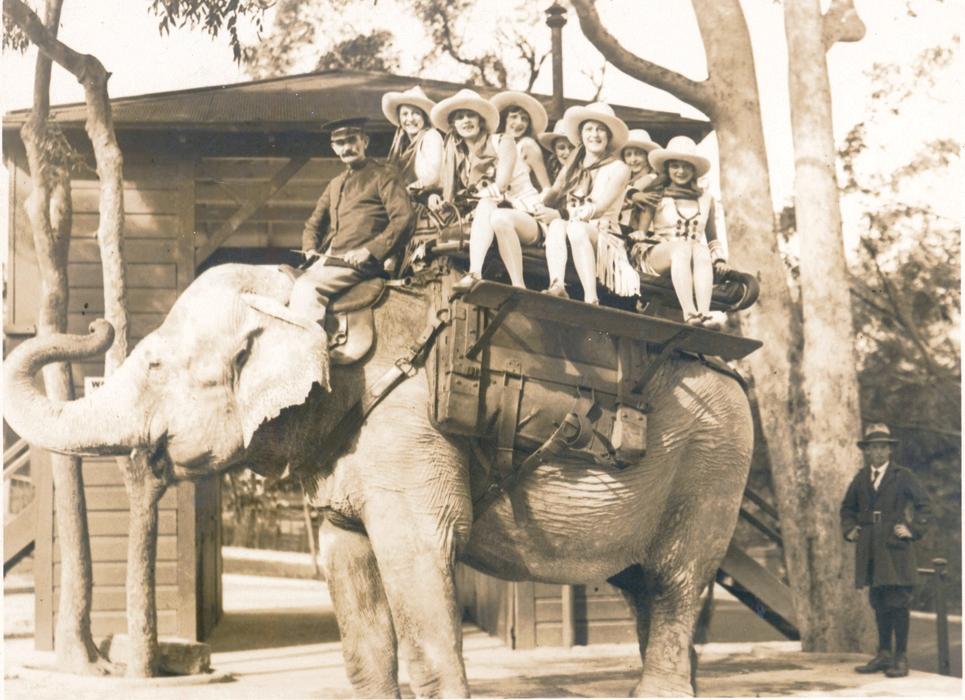
'Jessie', circa 1920
RECORD ATTENDANCE
The largest number of visitors In a year at the Moore Park Zoo was about 200,000. During Mr. Brown's first year at Taronga Park, 421,000 paid for admission. The peak attendance was In 1927, when 831,000 wont through tho turnstiles.
There was a drop to 482,000 In 1931, the result of the depression. Since then there has been an upward trend, and the attendances reached 671,000 In 1935. A little-known part of Taronga Park, in which Mr. Brown is flpoclally Interested, Is the section at the western end of the ground, where the appearance of natural bush has been carefully retained. Recently 150 Christmas trees were planted there to make a beautiful avenue. The only Inhabitant of this area Is a Canadian bison.
During the waterside strike in 1917, Mr. Brown stated that the Government took over the new Zoo area in a camp for free laborers and at one stage 1000 men were living there under canvas. For three months the gates were closed to the public, all costs of upkeep and salaries being paid by the Government. Mr. Brown joined the staff as a junior clerk in January, 1917, after recovery from wounds received In the Great War. SYDNEY ZOO (1937, January 11). The Maitland Daily Mercury (NSW : 1894 - 1939), p. 8. Retrieved from http://nla.gov.au/nla.news-article125461126
The Aquarium during late construction phases:
AQUARIUM AT TARONGA PARK.
ADDITIONAL ATTRACTION AT THE ZOO
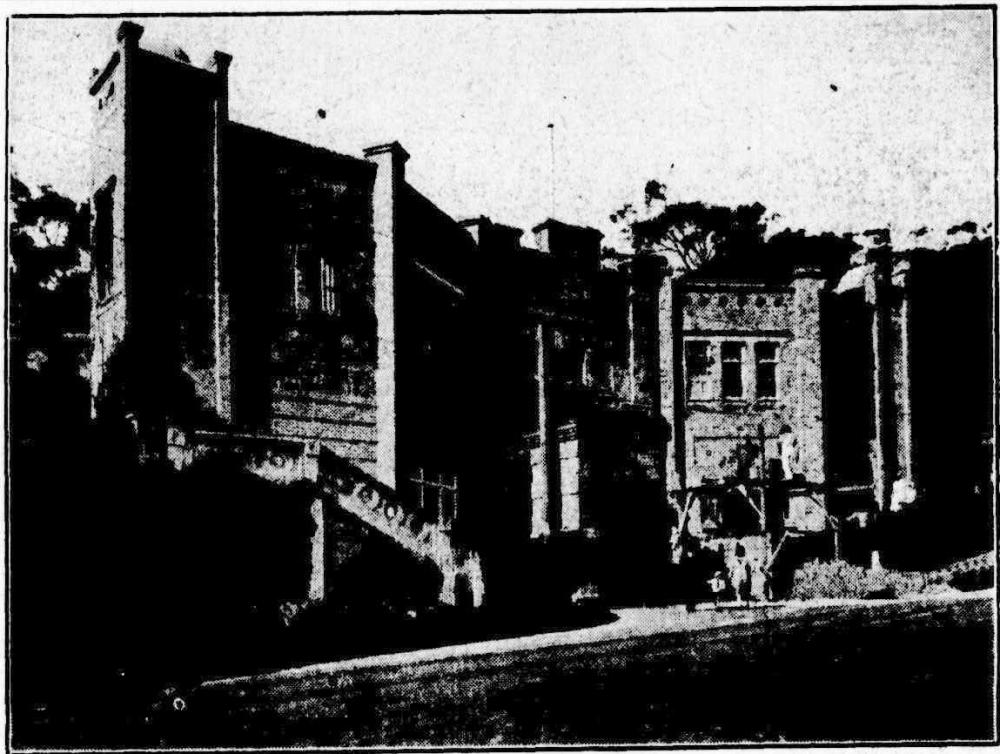
Good progress is being made with the construction at the Taronga Park Zoo of the aquarium, and it is hoped to have it completed and open to the public about Christmas time. AQUARIUM AT TARONGA PARK. (1926, October 30). The Sydney Morning Herald (NSW : 1842 - 1954), , p. 20. Retrieved from http://nla.gov.au/nla.news-article28059418
More may be learned about Professor Dakin in Dr. Isobel Bennett, a more recent history page during a focus on Pittwater heroes and heroines.
The word 'improvement' is repeated frequently during the next phase of Taronga developments and is one that recurs today, a ceaseless pursuit of improving the care of all animals housed in what is now named a 'zoo ark'. Along with the shift in perception of what 'improvements' are to prioritising the animals as much as attempting to attract new visitors - sometimes ideas that became obsolete can be seen and some that were renewed - all keeping close to being a 'garden' - perhaps a garden of Eden:
FLORAL CLOCK AT TARONGA PARK. SET IN MOTION BY SIR ARTHUR RICKARD YESTERDAY.
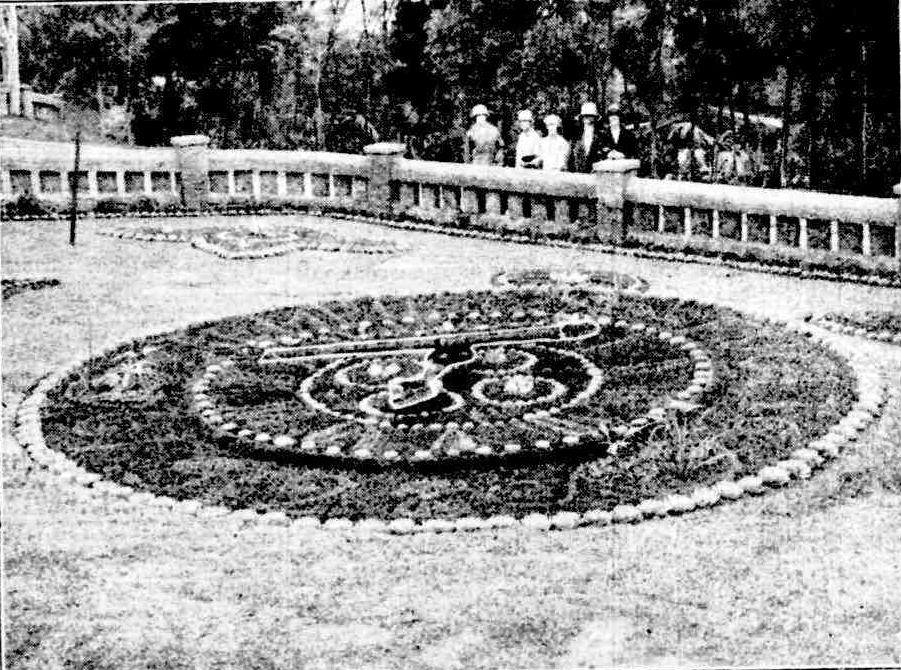
There are 11,000 plants in the face and hands. The time indicated in the picture is a quarter to six. FLORAL CLOCK AT TARONGA PARK. (1928, December 20). The Sydney Morning Herald (NSW : 1842 - 1954), p. 14. Retrieved from http://nla.gov.au/nla.news-article16517870
MINIATURE TRAIN AT THE ZOO.
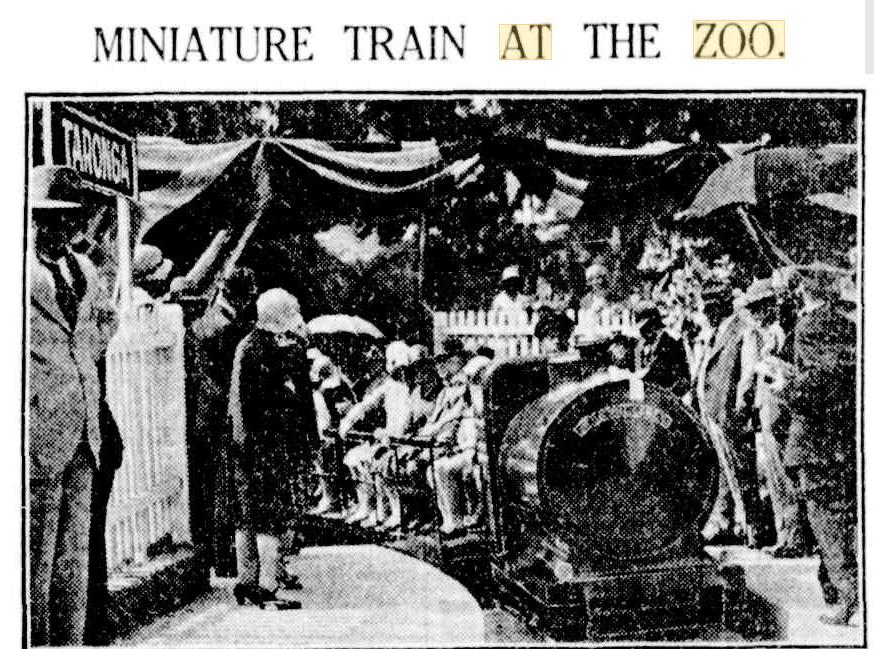
Adults vied with children to make the first trip from "Taronga" station yesterday, when the Minister for Lands (Mr. Ball) officially opened the line.MINIATURE TRAIN AT THE ZOO. (1929, December 10). The Sydney Morning Herald (NSW : 1842 - 1954), , p. 14. Retrieved fromhttp://nla.gov.au/nla.news-article16608685
TARONGA ZOO FILM
Colonel A. Spain, chairman, and the co-trustees of Taronga Park were entertained by Metro-Goldwyn-Mayer Ltd. at a special screening yesterday In that company's theatrette. They were shown the film record of the presentation to the Zoo by Mr. N. B. Freeman, managing director of Metro-Goldwyn-Mayer, of Leo Junior, son of M-Q-M's 'Living Lion' trademark, also scenes of the famous floral clock. The tint Issue of Heanl Metrotone News Reel, and 'A Perfect Day.1; the latest Stan Laurel and Oliver Hardy co-starring Hal Bosch comedy, were also on the programme. TARONGA ZOO FILM (1929, November 30). Evening News (Sydney, NSW : 1869 - 1931), p. 6. Retrieved from http://nla.gov.au/nla.news-article119009577
IMPROVEMENT COMPLETED AT TARONGA ZOO.
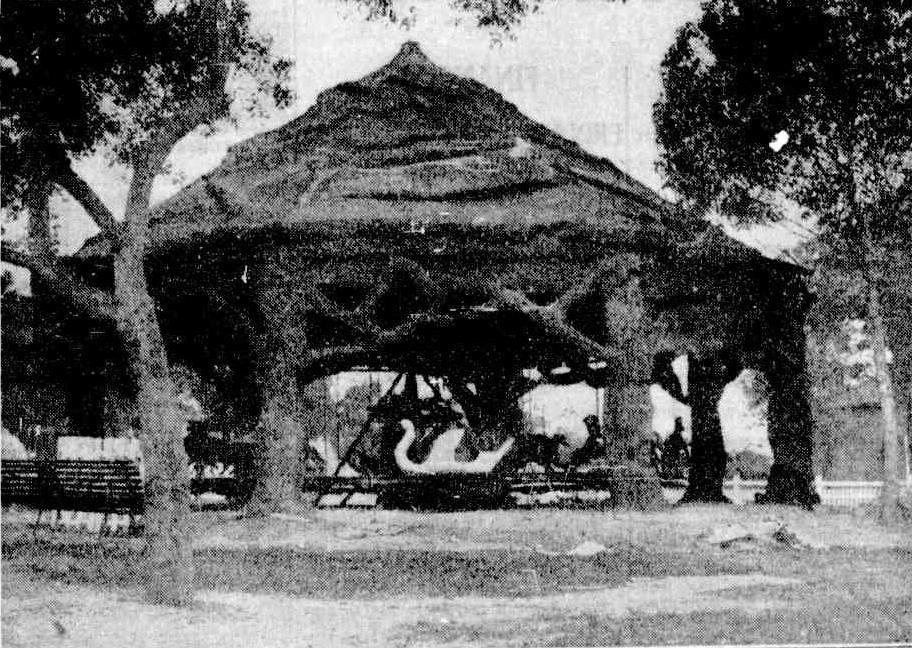
This picturesque cover has been placed over the merry-go-round in the recreation ground at Taronga Park. Its shade will be appreciated during the summer months by juvenile visitors. IMPROVEMENT COMPLETED AT TARONGA ZOO. (1931, October 9). The Sydney Morning Herald (NSW : 1842 - 1954), p. 12. Retrieved from http://nla.gov.au/nla.news-article16823936
A NEW ATTRACTION AT THE TARONGA ZOO.
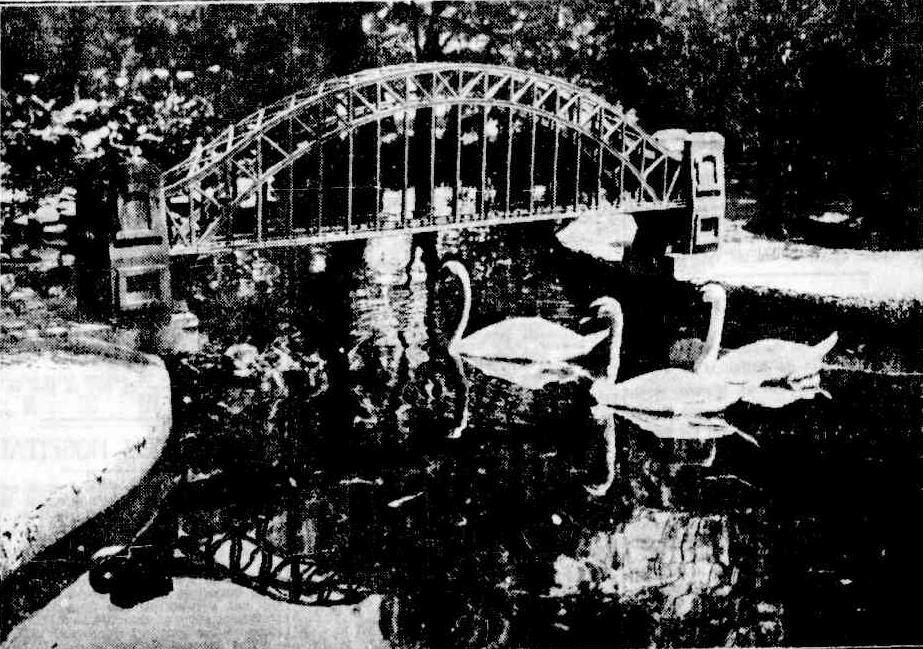
This model of the Sydney Harbour bridge, which has been erected in the swan pond at the Zoo, has attracted the interest of many visitors. A NEW ATTRACTION AT THE TARONGA ZOO. (1931, November 19). The Sydney Morning Herald (NSW : 1842 - 1954), p. 12. Retrieved fromhttp://nla.gov.au/nla.news-article16816146
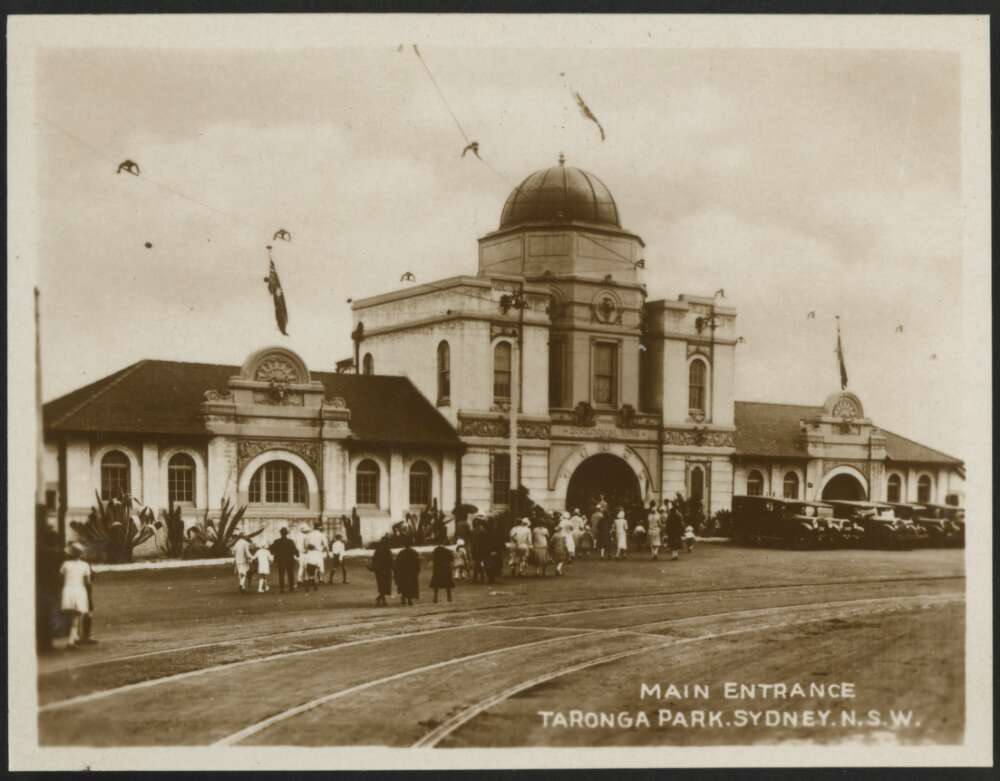
Facade of Main entrance, Taronga Park, Sydney, N.S.W. circa 193?. Courtesy National Library of Australia. Image No.: PIC Album 751 PIC/8731/234
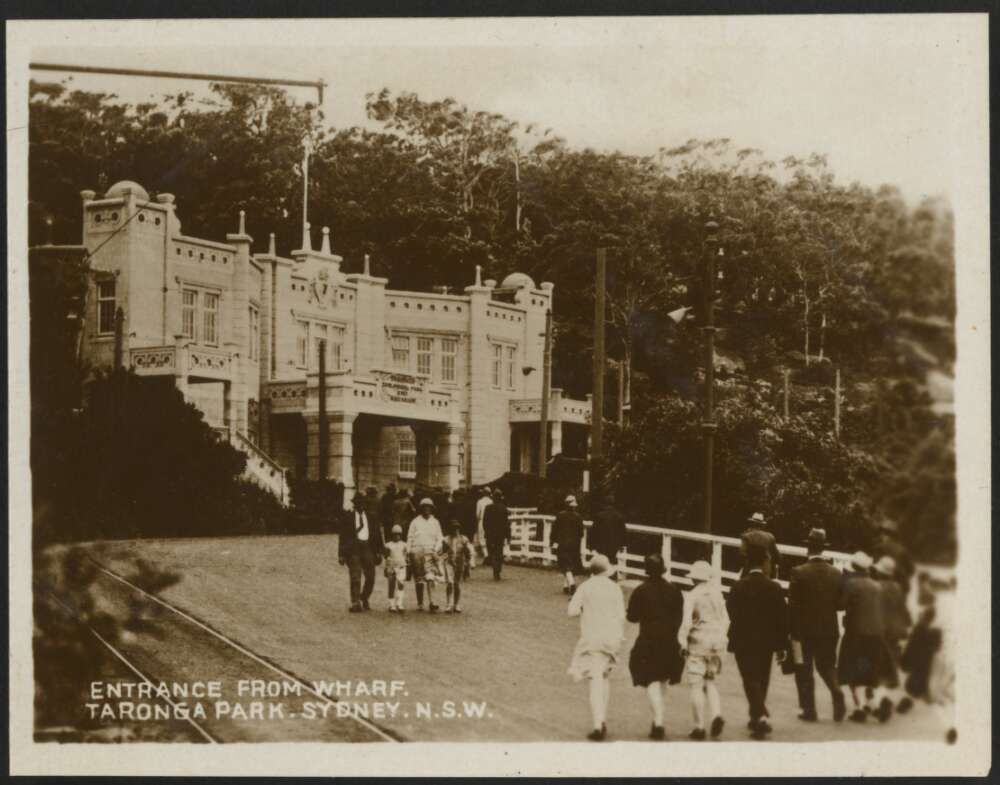
Entrance from wharf, Taronga Park, Sydney, N.S.W. [picture]. 193?. Courtesy National Library of Australia. Image No.: PIC Album 751 PIC/8731/237- showing how much bush was still visible.
TARONGA PARK ZOO.
Floral Clock Renewed.
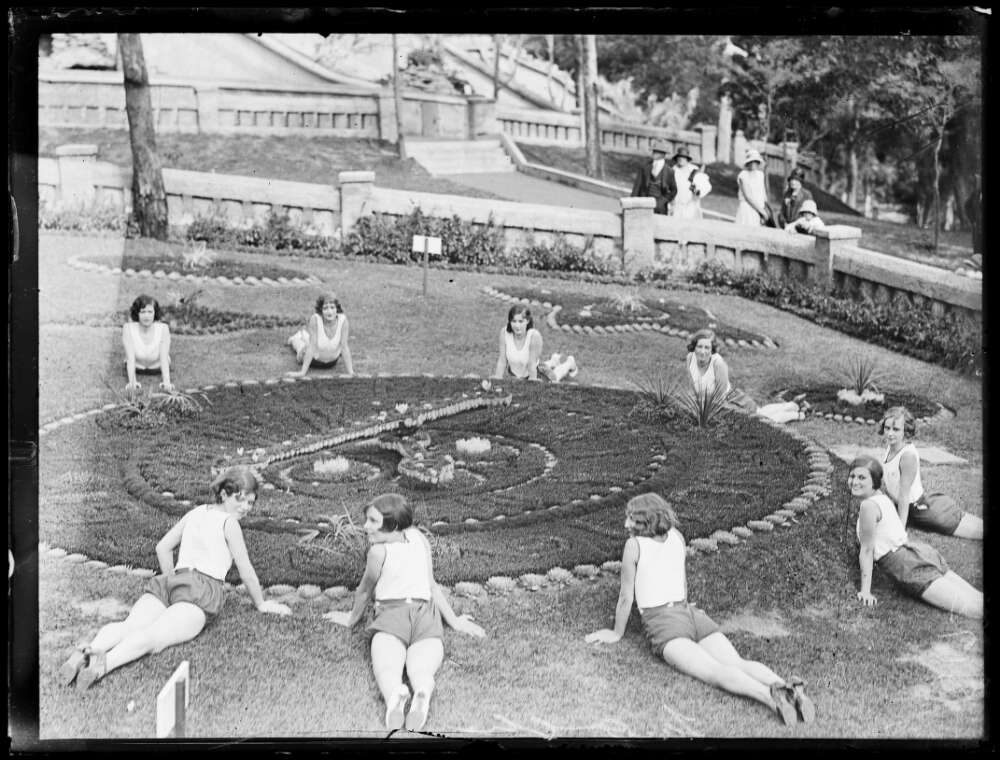
Women positioned on the hour marks of the floral clock at Taronga Zoo, Sydney, ca. 1930s. PIC/15611/8886 LOC Cold store PIC/15611 - courtesy National Library of Australia
Replanting the face of the floral clock and its surroundings at Taronga Park has been completed. About 200,000 plants were used — 100,000 on the clock and the balance on the grounds around it. Alteranthera, in colours of red and yellow, grown in the Trust's nursery, was used. The hands of the clock are finished off in moss. The mechanism, which was overhauled at the same time, was found to be running well.
Workmen are engaged on the construction of a tiger pit. The home for the two rhinoceroses from Africa, which are expected on the steamer Talleyrand on Monday morning, is ready for occupation. TARONGA PARK ZOO. (1938, October 6). The Sydney Morning Herald (NSW : 1842 - 1954), p. 10. Retrieved from http://nla.gov.au/nla.news-article17525459
TARONGA PARK ZOO ~
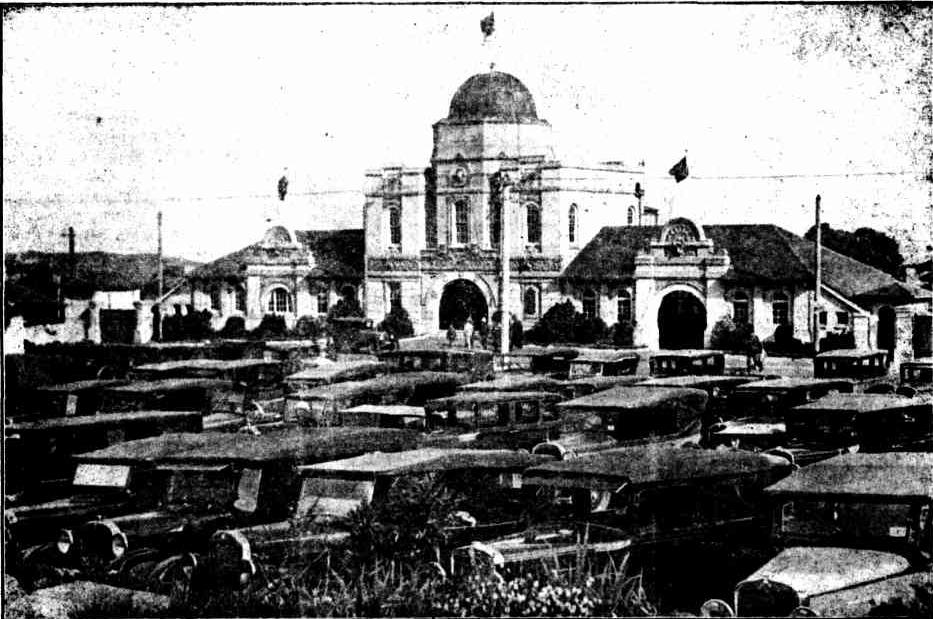
Top Entrance Gates of Sydney Zoo. TARONGA PARK ZOO (1940, April 2). The Muswellbrook Chronicle (NSW : 1898 - 1955), p. 6. Retrieved fromhttp://nla.gov.au/nla.news-article107533418
Sir Edward Hallstrom became a driving force for 'improvements' soon after this era, commencing with gifting two rhinoceroses and continuing as vice chairman, then chairman and an honourary director - for three decades. More may be read about Sir Hallstrom's enormous contributions to Taronga in another recent Pittwater hero page - Sir Edward John Lees Hallstrom.
In 1967 a shift towards scientific research, conservation and education, begun during the Hallstrom era, began o take precedence. New exhibits were built, including the Platypus and Nocturnal Houses, waterfowl ponds and walkthrough Rainforest Aviary. A Veterinary Quarantine Centre was opened as was an Education Centre (funded by the Department of Education). Outdated circus-style attractions such as the elephant rides, miniature train, monkey circus and merry-go-round made way to educational facilities such as Friendship Farm and the still popular Seal theatre.
In June 1973 a new Zoological Parks Board Act of NSW was enacted replacing the Trust with the Zoological Parks Board of NSW. More recently the Board further develop its research, conservation and education activities. Joint research projects are undertaken in conjunction with a number of institutions. Unique sub-units and partnerships were developed, such as the Australian Wildlife Health Network, the Australian Marine Mammal Research Centre, The Taronga Training Institute and other associated capabilities.
In 2008-2009 the Board was renamed the Taronga Conservation Society Australia to better reflect the range of national and global initiatives TAronga is now a part of. Taronga Zoological Gardens, now known as a Zoo Ark, is still one of the world's best zoos, as our species shifts from 'taming' the wild to ensuring the survival of endangered species.
Details regarding next Saturday's parade run below - as do what happened on Friday 7th October, the official birthday of this wonderful zoo:
Taronga ‘Stands Up For The Wild’ With 100 Year Birthday Parade
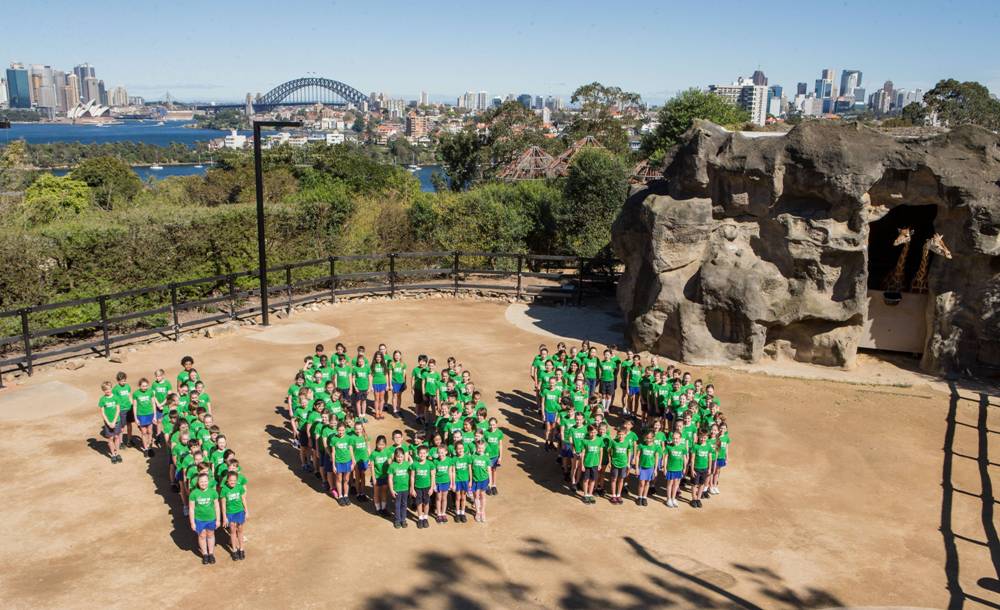
School children celebrate 100 years of Taronga Zoo - photo by Rick Stevens
A parade of giant animal light sculptures will make their way down Macquarie Street, Saturday 15 October, Taronga Zoo announced today,marking100 years since the Zoo officially opened in Mosman in 1916.
Starting at Hyde Park at 8pm, the amazing light sculptures will be escorted by a cast of school children who will dance, sing and light up the streets for the wild to the Sydney Opera House, where a live performance will take place.
The giant animal light sculptures represent Taronga’s ten year commitment to the conservation and preservation of 10 Centenary Species, iconic and beloved animals which include the Asian Elephant, Platypus, and Sumatran Tiger.
The fabulous light parade will recreate the historic moment 100 years ago, when Jessie the elephant made her way from the original Zoological site in Moore Park, through the CBD, down Macquarie Street to a spot on the foreshore directly where the Harbour Bridge and Opera House would rise years later. Jessie boarded a barge, to be transported across the harbour as did hippos, primates, reptiles, and many other animal species Taronga still cares for today.
Taronga is encouraging Australians to ‘Stand Up #FortheWild’ by coming along to cheer the parade or by donating to its Centenary Commitment to turn around the plight of these 10 critical species.
Creative Director, Ignatius Jones, said: “This will be the most amazing parade that Sydney has seen in a 100 years! An absolute carnival of lights, dancing and music!”
“A great night out for friends and families, the Taronga Birthday Parade will spread the word that we need to stand up for these amazing animals and help Taronga ensure their future.”
Taronga Zoo’s CEO, Cameron Kerr said: “We’re inviting everyone in Sydney to ‘Stand Up for the Wild’ by coming along to what will be an amazing spectacle and help support the work being done for these 10 vital species.”
“We’re asking Australians not just in Sydney but across the country help us raise $1 million dollars to kick-start a lifetime conservation commitment.”
The parade is the exciting culmination for Taronga’s Centenary program, presented by long-term supporter ANZ, which has also included Vivid Sydney at Taronga, EID at Taronga, inviting guests to come in for $1 on their birthday, creating a stunning collection of past and present Taronga memories at #IGrewupWithTaronga, hosting an amazing birthday party on the 7 October Centenary anniversary and the commencing of amazing field-work to conserve the 10 Centenary species.
Donate $10 to help Taronga save 10 endangered species from extinction. Visit: tarongaparade.org
What: Taronga Birthday Parade
Cost: FREE
When: Saturday 15 October 2016 at 8pm
Where:Starting from Hyde Park North and continuing along Macquarie Street to the Sydney Opera House grand finale performance
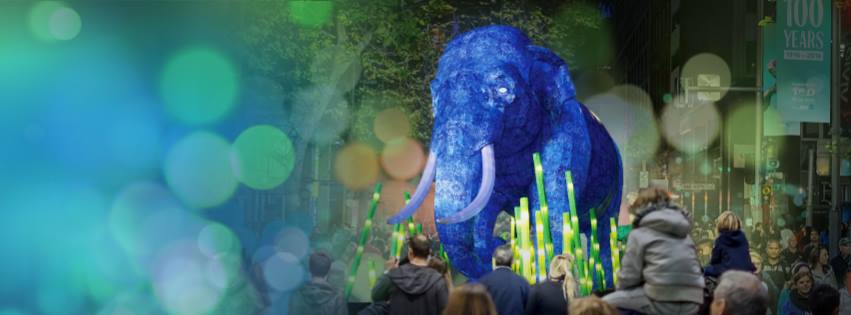
Taronga Celebrates 100th Birthday
Friday, October 7, 2016 - by Taronga Zoo
Taronga Zoo celebrated its 100th birthday today, serving up surprises for its giraffes, elephants and more than 6000 guests to mark a century of bringing people and wildlife together.
The Centenary celebrations began at the giraffe exhibit, where Taronga’s tallest animals were treated to a special birthday breakfast before opening hours. Keepers decorated the exhibit with a giant number “100” made from leaves, giving the giraffes a chance to use their amazing 20-inch tongues to retrieve the tasty treats.
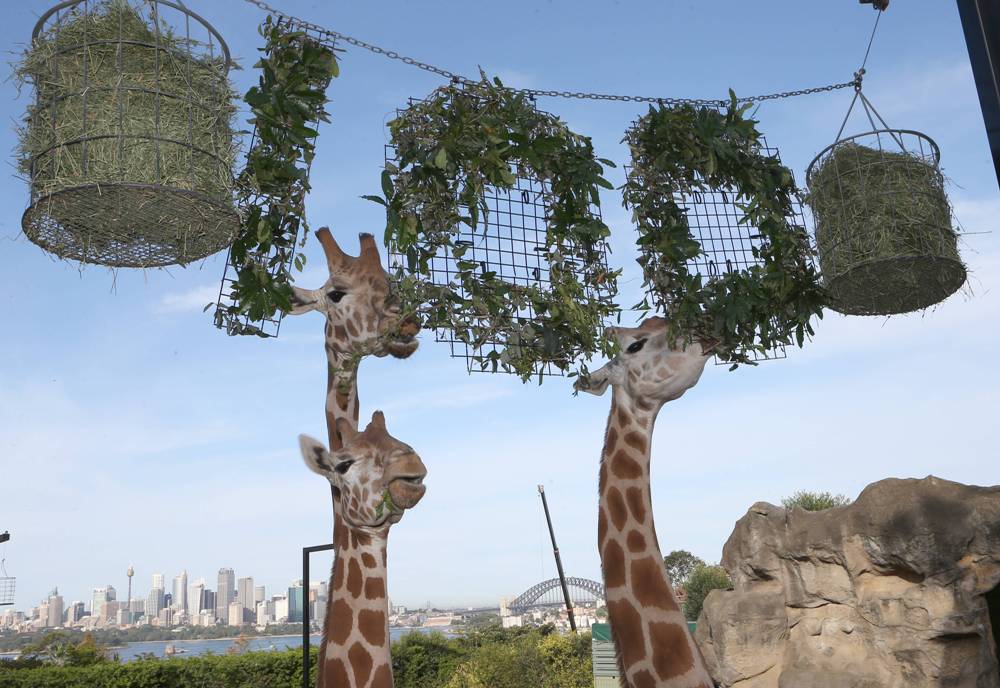
Giraffes enjoy a special breakfast for Taronga's 100th Birthday. Photo by Rick Stevens
NSW Environment Minister, Mark Speakman later joined Taronga CEO Cameron Kerr at the Zoo’s historic entrance building to cut the ribbon and officially launch the birthday festivities, with a little help from Taronga’s rescued Fiordland Crested Penguin, Munro.
Mr Speakman said wildlife conservation had come a long way in the 100 years since Taronga Zoo first opened its gates in Mosman on 7 October, 1916 after moving from Moore Park.
“Over the past century, Taronga has transformed itself from a place of entertainment to a mature conservation hub that works well beyond traditional zoo boundaries to prevent the poaching and trafficking of wildlife, protect and regenerate critical habitat, and increase understanding of wildlife across the globe,” Mr Speakman said.
“I’d like to congratulate Taronga’s staff, supporters and the army of volunteers who continue to work so passionately and energetically to achieve the Zoo’s vision of a shared future for wildlife and people.”
Five thousand lucky supporters won free tickets to visit Taronga on the 100th birthday by entering a Birthday Ballot.
Guests were treated to a day of delights, including special animal experiences and presentations, lucky door prizes, performing artists, keepers in historic uniforms and a nearly two-metre-long birthday cake in the shape of Taronga’s famous entrance.
Taronga’s CEO, Cameron Kerr said the Centenary was a chance to celebrate the Zoo’s first 100 years and also launch a legacy for the future of wildlife conservation.
“In this pivotal 100th year, we are setting out to make a lasting and positive impact on the future of 10 vitally important species from Australia and Sumatra,” he said.
“From the magnificent Asian Elephant to the tiny Corroboree Frog, Taronga has committed to support these species for the next decade, and over this time effectively turn around their fate so they can thrive for another 100 years."
Taronga’s Asian Elephants also received a birthday surprise from Centenary Presenting Partner, ANZ, with keepers hanging up enrichment items in the form of piñatas filled with the elephants’ favourite foods.
ANZ Group Executive, Australia, Fred Ohlsson said: “Taronga Zoo is an extraordinary place, loved by so many people. Generations of Sydneysiders grew up with Taronga and for countless interstate and international visitors, Taronga is a special place they’ll remember forever. ANZ is proud to help Taronga celebrate its Centenary and continue our long history of supporting the community in NSW.”
Taronga’s Centenary celebrations will continue on Saturday, 15 October with the 100 Year Birthday Parade.
Australia Post Encourages Students To Learn About Endangered Wildlife
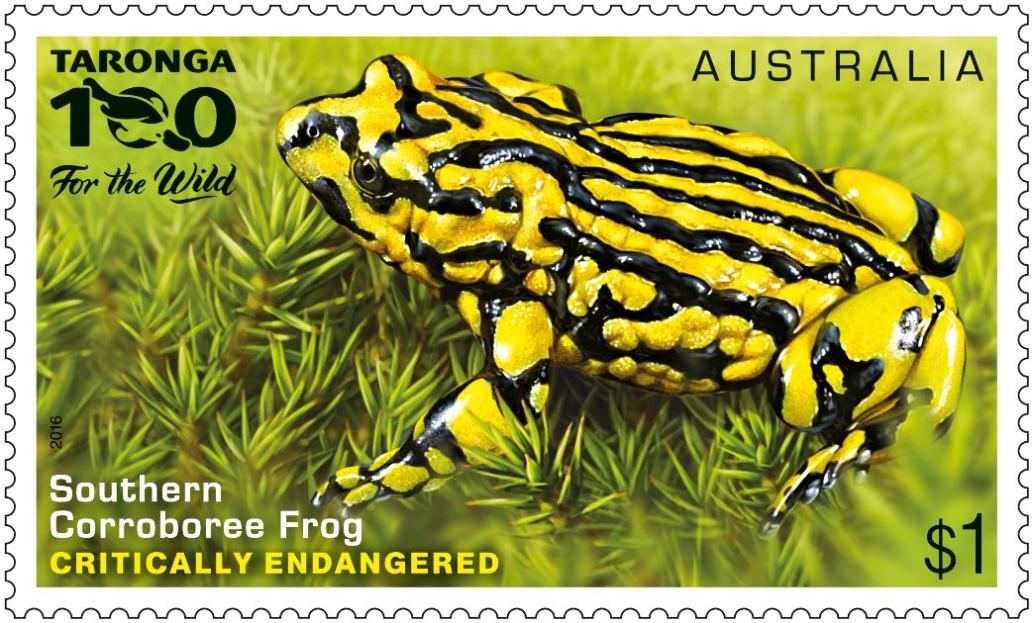
$1 Endangered Wildlife, Southern Corroboree Frog stamp.
Australia Post Encourages Students To Learn About Endangered Wildlife
26th September 2016
Australia Post is calling young Australians to get on board Stamp Collecting Month this October to learn more about some of the world's most endangered animals through the endangered wildlife stamp issue.
Encouraging children to learn more about animal conservation, the Endangered Wildlife stamp issue features four native and three exotic endangered animals currently part of local zoo or Government conservation programs.
With Australia losing nearly 30 mammal species in the last 200 years, Taronga Zoo Executive Director, Cameron Kerr said the country has one of the highest extinction rates in the world.
"Fortunately, organisations like Taronga Zoo are working to help species like the Southern Corroboree Frog that are in serious trouble. Through joint breeding programs, we're already releasing these critically endangered amphibians to Kosciusko National Park. With less than 50 of these animals left in the wild our timing is crucial.
"The impressive stamp representing this striking frog helps commemorate Taronga Zoo's centenary, but also creates awareness for their plight in the wild and we are proud to have it featured for Stamp Collecting Month," said Mr Kerr.
"This year's Stamp Collecting Month is a great opportunity for students, teachers and parents to explore and delve deeper into some of our endangered species, the causes of endangerment and extinction and what we can do to help protect them," he said.
With the issue's focus on animals at risk of extinction, Australia Post Philatelic Manager, Michael Zsolt, said, "We are pleased to recognise the efforts being made to conserve endangered species and to get behind such an important cause".
The stamps feature the Snow Leopard, Asian Elephant, Western Lowland Gorilla, Western Swamp Tortoise, Orange-bellied Parrot, Northern Quoll and the Southern Corroboree Frog.
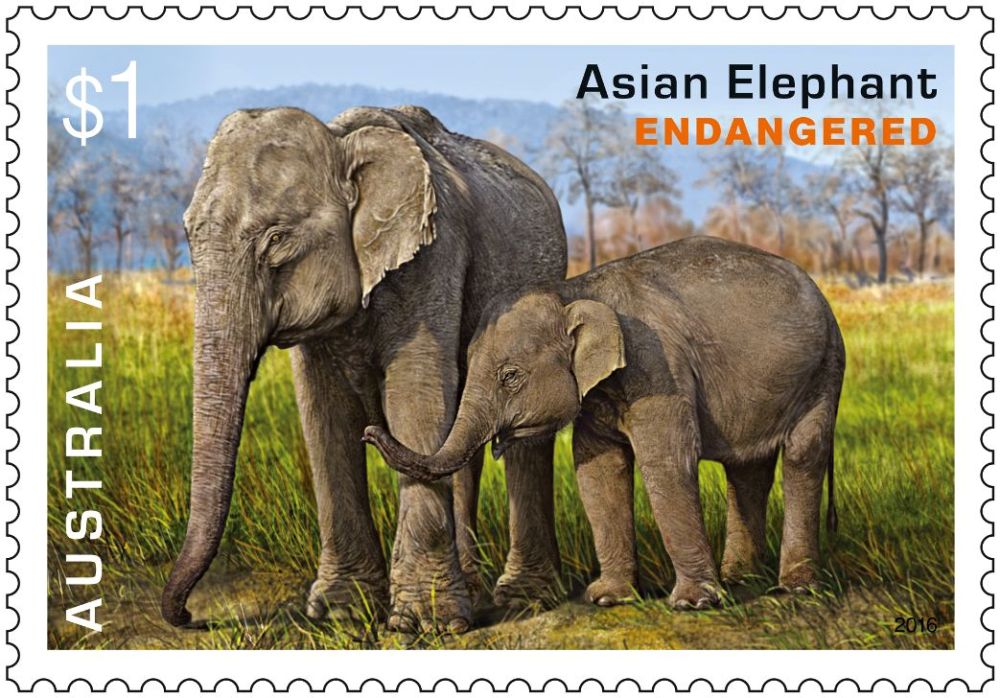
$1 Endangered Wildlife, Asian Elephant stamp.
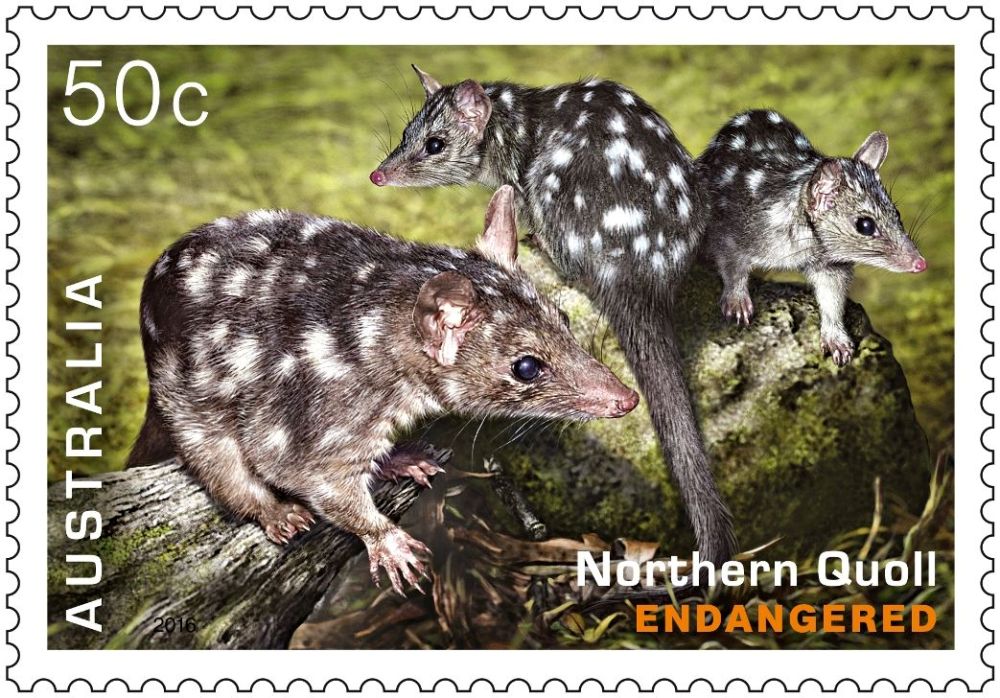
50c Endangered Wildlife, Northern Quoll stamp.
Stamp Collecting Month is also supported by a dedicated online education resource for teachers, parents and students. The website includes information and facts on each animal featured, as well as lesson ideas and activities, stamp images and much more.
For more information on Stamp Collecting Month and this year's Endangered Wildlife issue, including educational activities, visit the website:www.auspost.com.au/scm.
The Endangered Wildlife stamps and associated products are available from 20 September 2016 at participating Post Offices, via mail order on 1800 331 794 and online at www.auspost.com.au/stamps while stocks last.
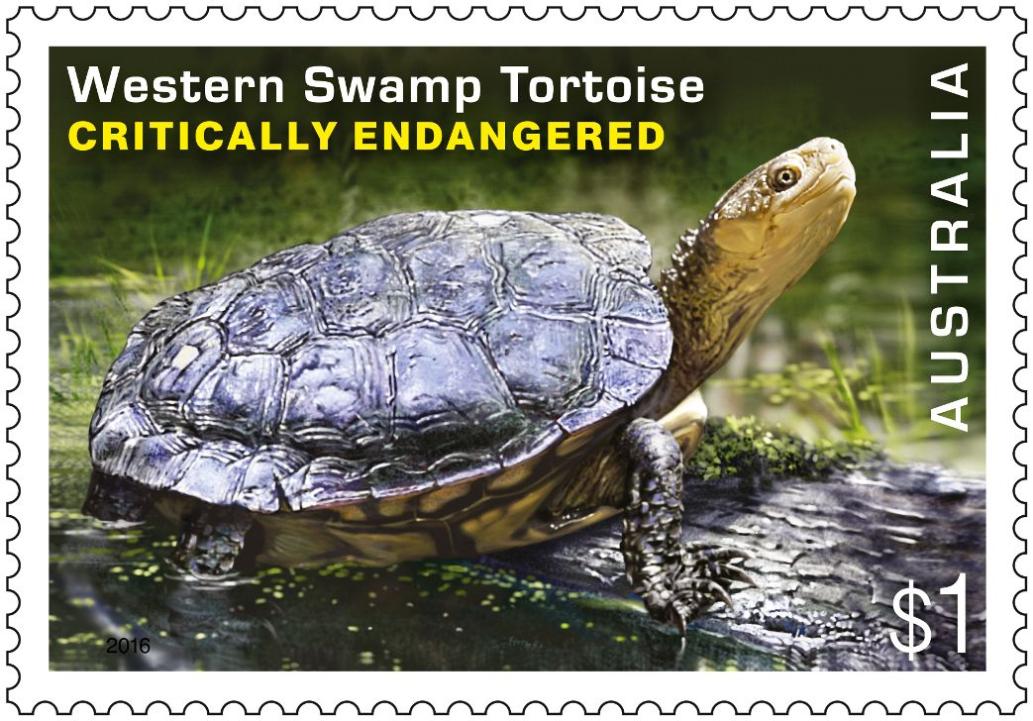
$1 Endangered Wildlife, Western Swamp Tortoise stamp.
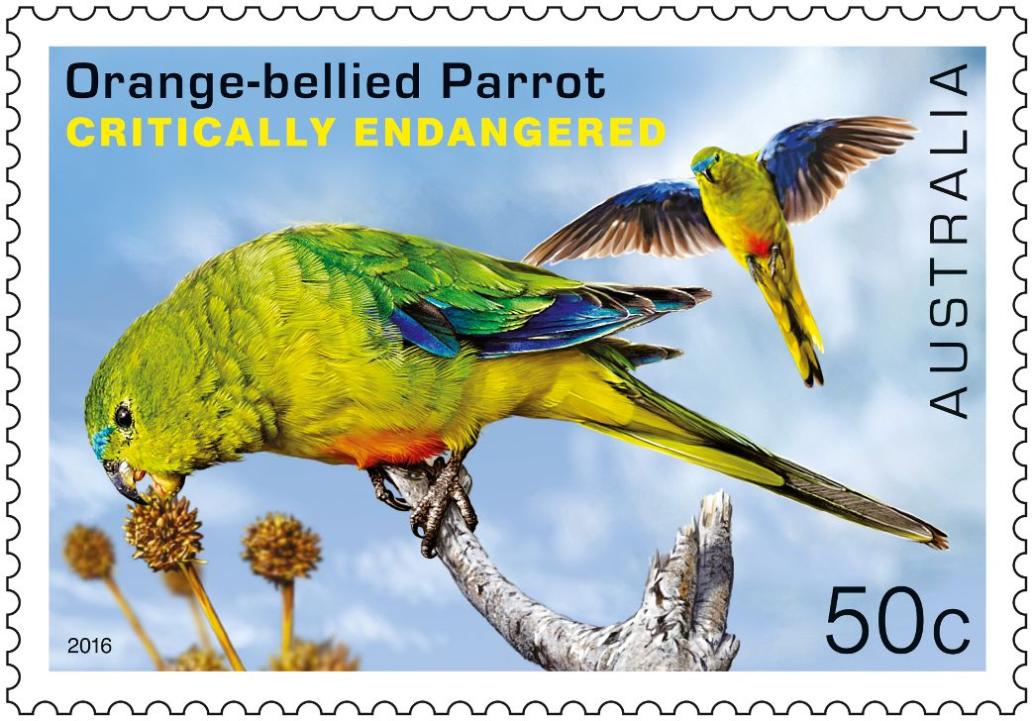
50c Endangered Wildlife, Orange-bellied Parrot stamp.
Extras and Notes
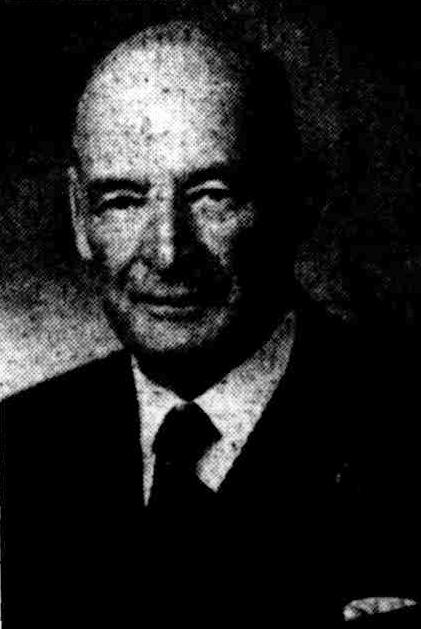
N.S.W. GOVERNMENT RESIGNS.
A DISSOLUTION REFUSED. .
MINISTRY IN A MINORITY.
SYDNEY , July 27.
In the Legislative Assembly shortly after 5 o’clock tins afternoon the Acting Premier (Mr. Holman) announced to the House that he had tendered the resignations of himself and his colleagues to the Lieutenant-Governor (Sir William Cullen) and had tendered certain advice. His Excellency could not accept that advice and suggested that the Premier (Hon J S T McGowen) should first be communicated with.
The Acting Premier further announced that tonight a cable would be sent to Mr McGowen. He then moved the adjournment of the House.
Mr Wade objected that the whole procedure his irregular. Only the Premier could tender the resignation of the Government
A Debate followed and it was subsequently announced that the resignation of the Government had been it accepted and the House adjourned till Tuesday next.
In the meantime a cable will be sent to the Premier (Mr. McGowen) who is at Yukon, Canada, and on receipt of his reply the Lieutenant-Governor will send for his successor to form a Cabinet.
It is understood that the advice which Mr. Holman gave but which the Lieutenant-Governor could not accept, was for a dissolution.
The action of the Labour Minister is due to the fact that since Messrs. Horne and Dunn Country Members of the Labour Party resigned their seats a couple of days ago over the land policy of the Minister for Lands in relation to freeholds the Government has been in a minority and could only carry on with the support of the In dependents whose help could not b relied upon.
RESIGNATION_OF SPEAKER
A NOVEL SITUATION
The latest development in the political situation is that Mr Cann, the Speaker of the Assembly who was elected as a Labour member his resigned the Speakership to join his party on the floor of the House. This will make the members 44 on each side counting the Independent with the Liberals.
If Mi Wile accepts the responsibility of office it devolves upon him to arrange for a new Speaker and it is understood that no Labour man will accept the Speakership so Mr Wades nominee in the chair will leave his party in a minority of one. N.S.W. GOVERNMENT RESIGNS. (1911, July 28). The Mercury (Hobart, Tas. : 1860 - 1954), p. 5. Retrieved from http://nla.gov.au/nla.news-article10109274
DEATH OF COLONEL SPAIN
OUTSTANDING PERSONALITY PASSES.
The death of Colonel Alfred Spain, on Monday last at the splendid age of 86, removes an outstanding personality from the Australian scene. He was one of those indomitable characters who appear to succeed at everything they undertake, and during his long life he had achieved distinction as an architect, soldier and administrator, while he had always been active in business, being a director of a number of important organisations.
Col. Spain was born at "Warraringa," Neutral Bay, in 1868, and he had lived in this Harbour-side district ever since. After receiving his preliminary education at the Queen's School, in 1891 he commenced his career as an architect and in due time became a partner in the firm of Rowe, Campbell and Spain (hitherto Thomas Rowe and Green), which later became Thomas Rowe and Spain, and still later in 1904 Spain and Cosh. All the partnerships were outstanding. Mr. Campbell, of Thos. Rowe, Campbell and Spain, was a classic architect and had been a great lecturer in his day. Amongst the fine work then erected was Gardener's Building, which went through from York Street to Clarence Street, and is now the B.G.E. on the Clarence Street side and Charles Parsons on the York Street side. Mr. Campbell died before the days within most of our living memories, but the firm continued as Rowe and Spain with the city's leading structures — the Sydney Hospital, the Synagogue, all the arcades, countless churches and warehouses, Hoffnung's Building in Pitt Street where the Post Office now stands, Elliott Bros, in O'Connell Street, and all the fire stations. The good work was continued after Mr. Rowe's decease by Spain and Cosh. They had a lasting connection with their clientele because of the fine standard of work.

THE LATE COLONEL ALFRED SPAIN.
In addition to his architectural activities, Colonel Spain had a long military record, and from 1890 to 1920 served with the Australian Engineers and as Officer Commanding with field companies in Sydney. During World War I, he organised and commanded Engineers A.I.F. Reinforcements Camp, Paddington, later seeing service abroad with the A.I.F.
Taronga Park.
One of his best loved activities was his Presidency of the Taronga Park Trust, and these beautiful Zoological Gardens, famed throughout the world, are, in many respects, living memorials to his foresight, architectural skill and unbounded enthusiasm. It was on his suggestion that the Taronga Park site was selected, but, even so, it was acquired only after the usual "battle of the site" that seems to accompany such changes, had been fought. Colonel Spain won the victory. He relinquished this post in 1941 after many years' service. He also rendered great service as a citizen and was a Past President to the Royal Empire Society, Deputy President of the United Services Institution and was a President of the Town Planning Association of New South Wales for a number of years.
In the business world he was Chairman of Sydney Ferries until 1951, of Katoomba and Leura Gas Co. Ltd., and a director of Hetton Bellbird Collieries Ltd., Howard Smith Ltd. and Grenfell Gas Co. Ltd.
He had a lifelong love of the sea, and his main recreations were yachting and fishing. He was awarded the Royal Shipwreck Relief Society's Silver Medal for gallantry for saving life in Sydney Harbour.
A Personal Contact.
The Editor of this journal knew Colonel Spain personally as far back as 1900, from the time she served her articles with Edward Skelton Garton in Vickery's Chambers in Pitt Street, now Queensland Insurance Building, where the then Rowe and Spain had their practice in the front of the building, on the fourth floor, all to themselves. It had a mansard roof with dormers along the front, and ample accommodation for the 40 draftsmen who comprised their staff. The building had originally been built over a stable, and at the back there was space enough for horses to prance.
Coincidentally, it was in the caretaker's quarters that had been turned into a printery, that Building Publishing Company printed its monthly publications, from October, 1907, until 1912—in the heart of all the architectural, building and engineering activity. A life-long friendship developed with Colonel Spain between both George and Florence Taylor.
The quality that most people will remember him by, is his brilliant mastery of his subjects. He seemed to know everything in a very intimate way about everybody who did things worth while. Conversation was always lively. Extra to this, she remembers him for his largeness of soul, his love of animals and birds, and above all the arts, including poetry (in which she, too, had always delved). He could supply and quote poetry for every occasion.
In July. 1924, it was her privilege to be the representative of the Institute of Architects of N.S.W., together with Sir John Sulman and Colonel Alfred Spain, when the R.I.B.A. held an Architects' Convention at Oxford University. The influence and the lovely memory that these two gentlemen left upon her she regards as one of the most cherished possessions of life. Sir John Sulman died in August, 1934, and Colonel Spain on August 9, 1954. If one endeavoured to plan a life of service and achievement it would be difficult to find a more complete pattern than that of Colonel Spain. Dapper, precise, optimistic and full of the will to do things, his presence in Sydney will indeed be greatly missed. DEATH OF COLONEL SPAIN (1954, August 11).Construction (Sydney, NSW : 1938 - 1954), p. 1. Retrieved from http://nla.gov.au/nla.news-article224516978
Taronga Zoo 100th Birthday Parade: 1000 Reasons To Celebrate - threads collected and collated by A J Guesdon, 2016